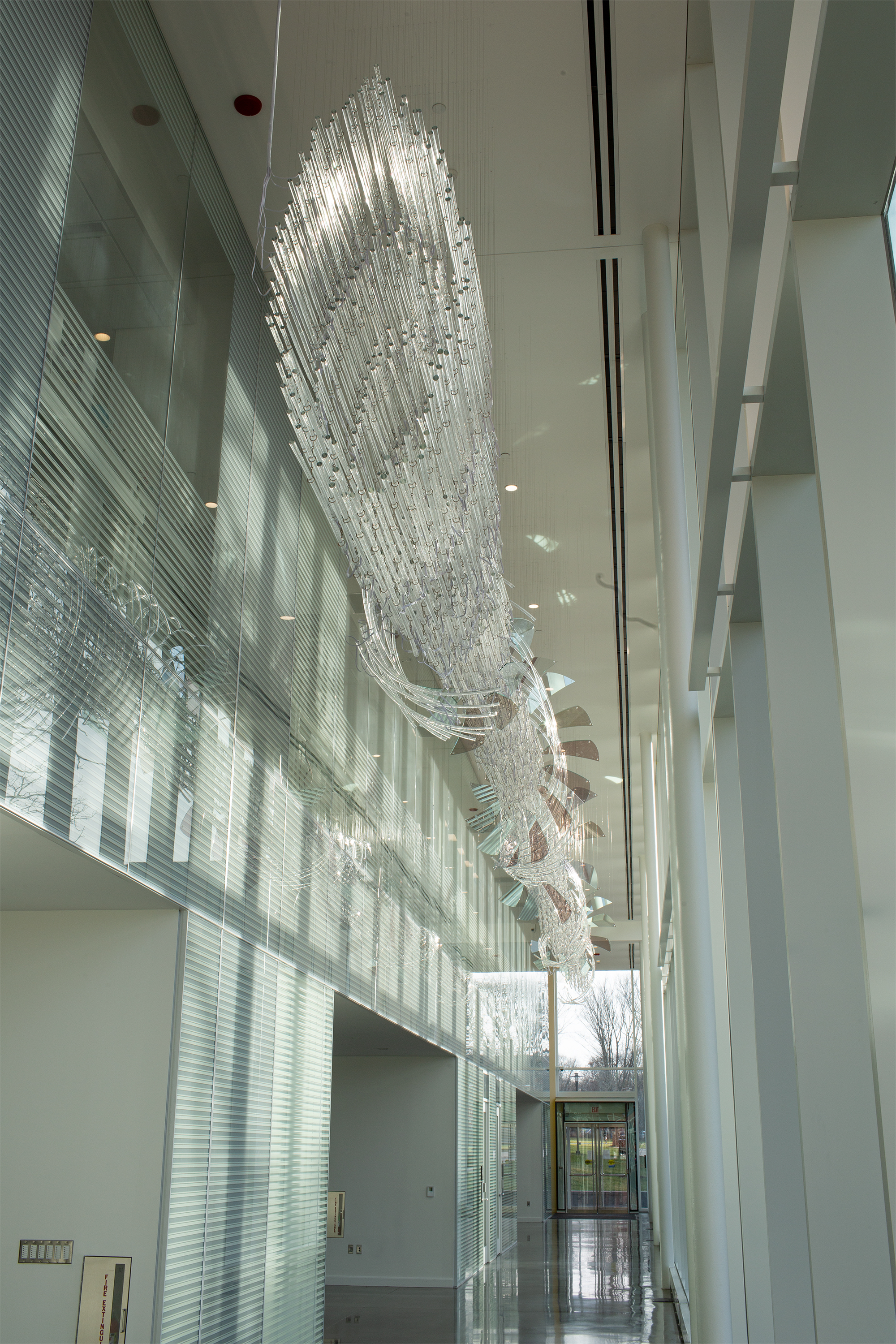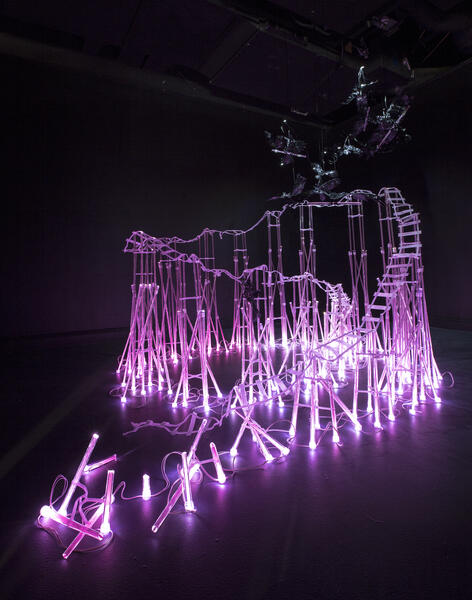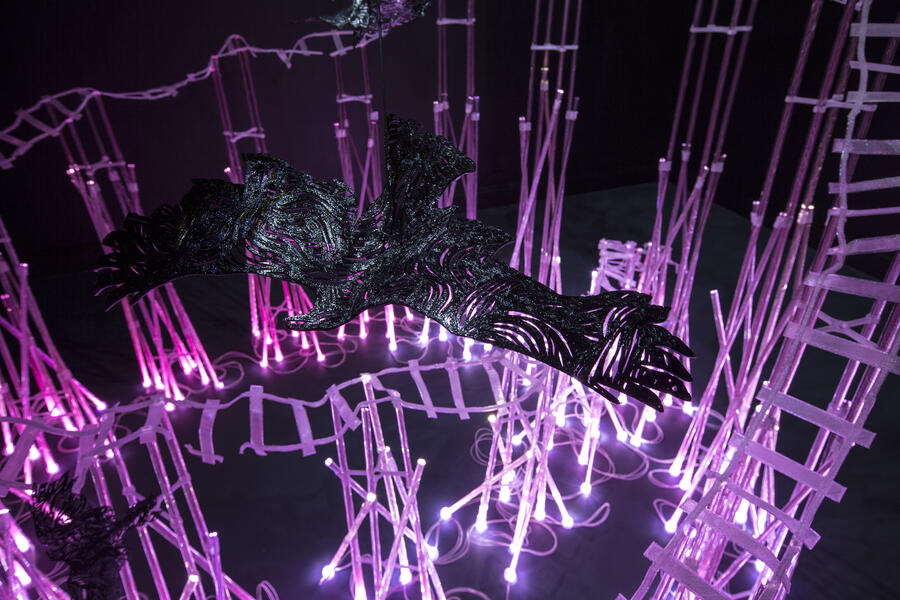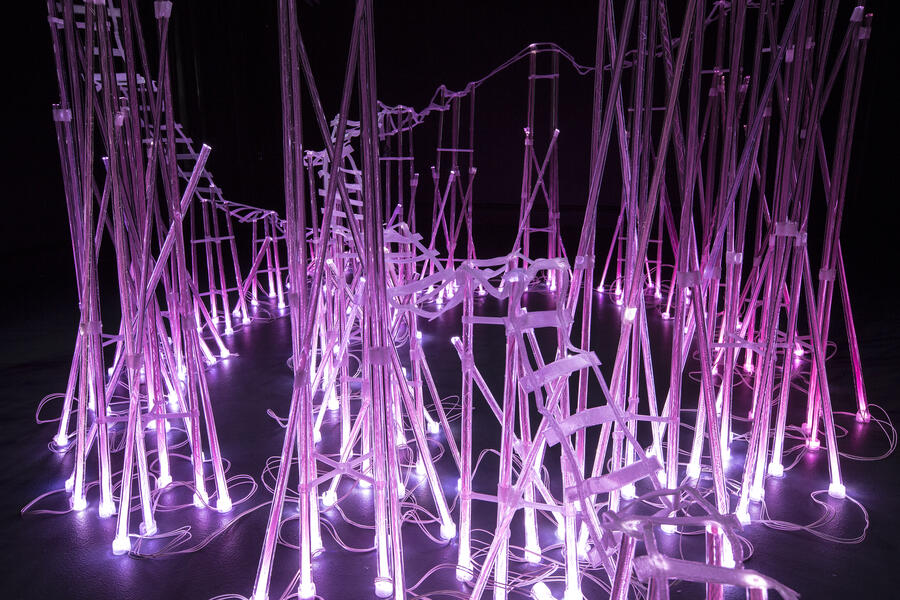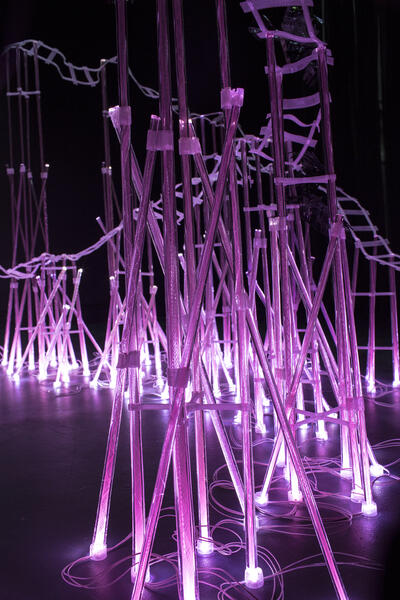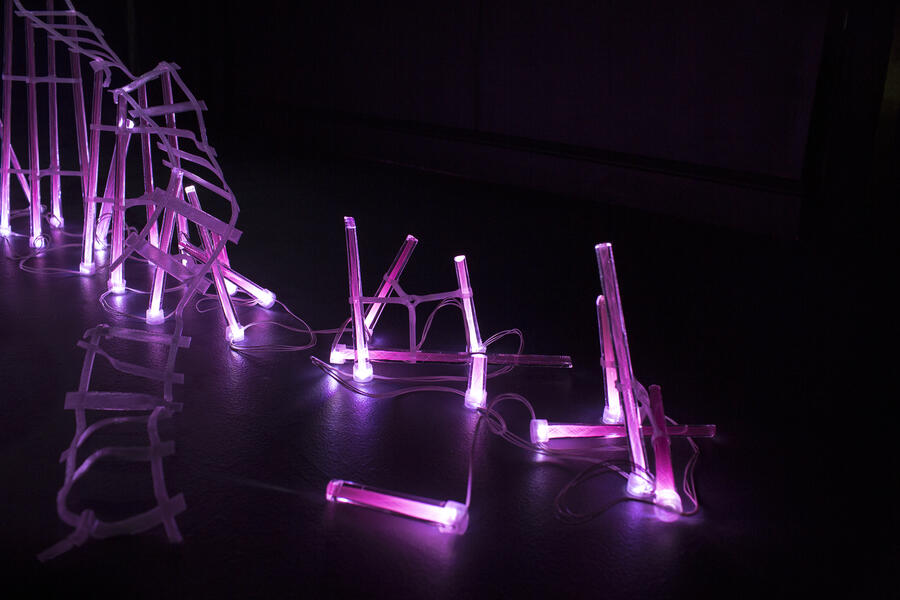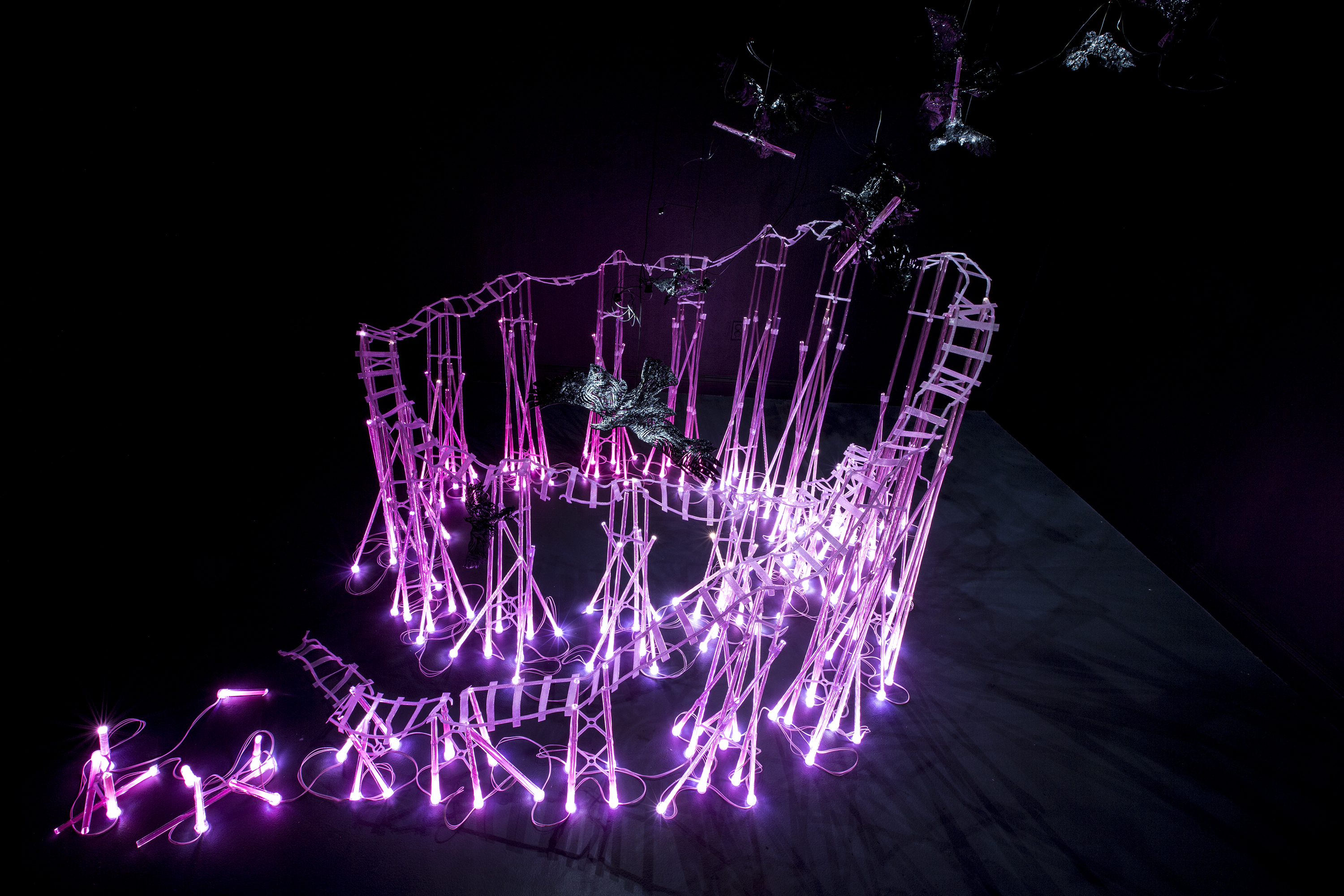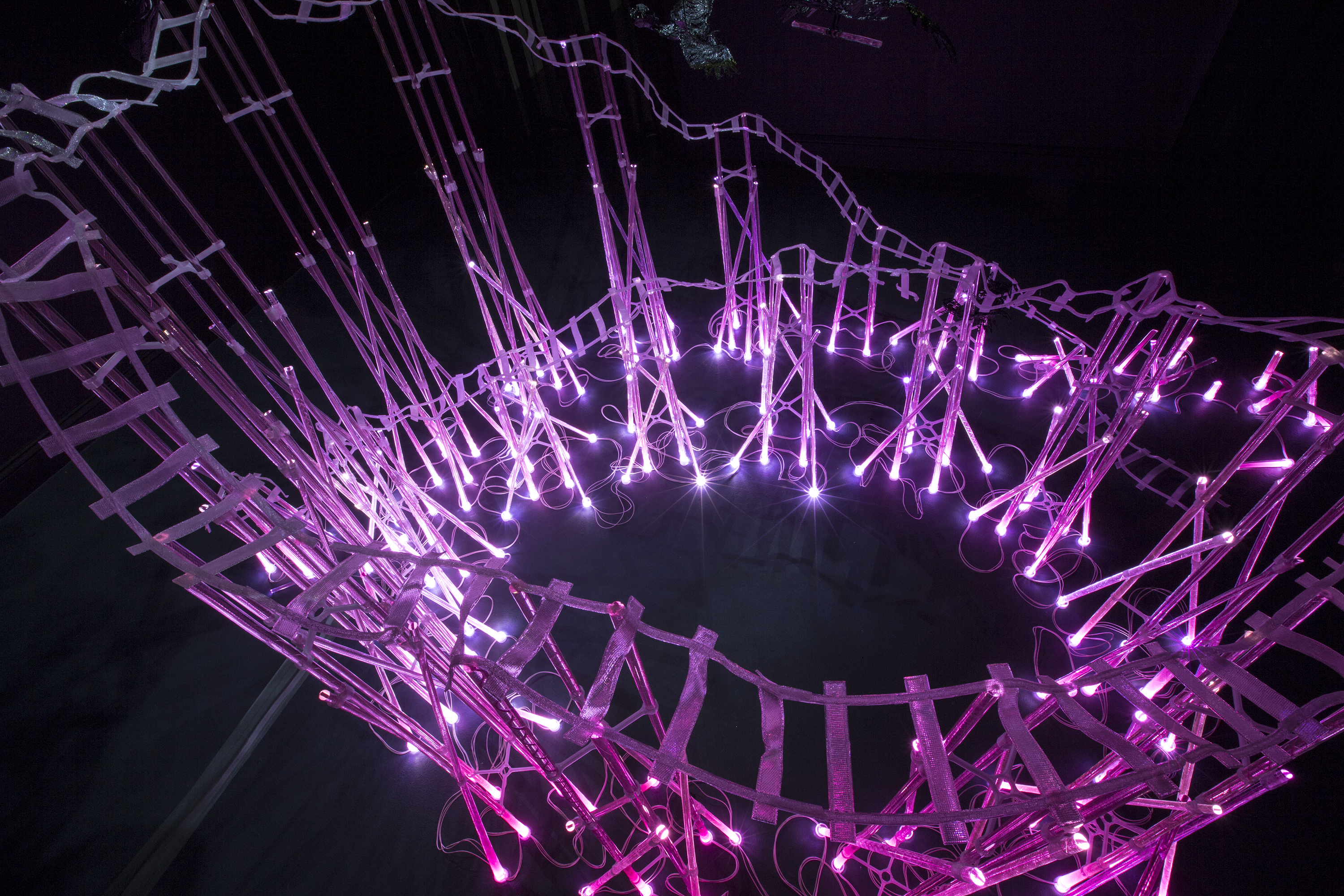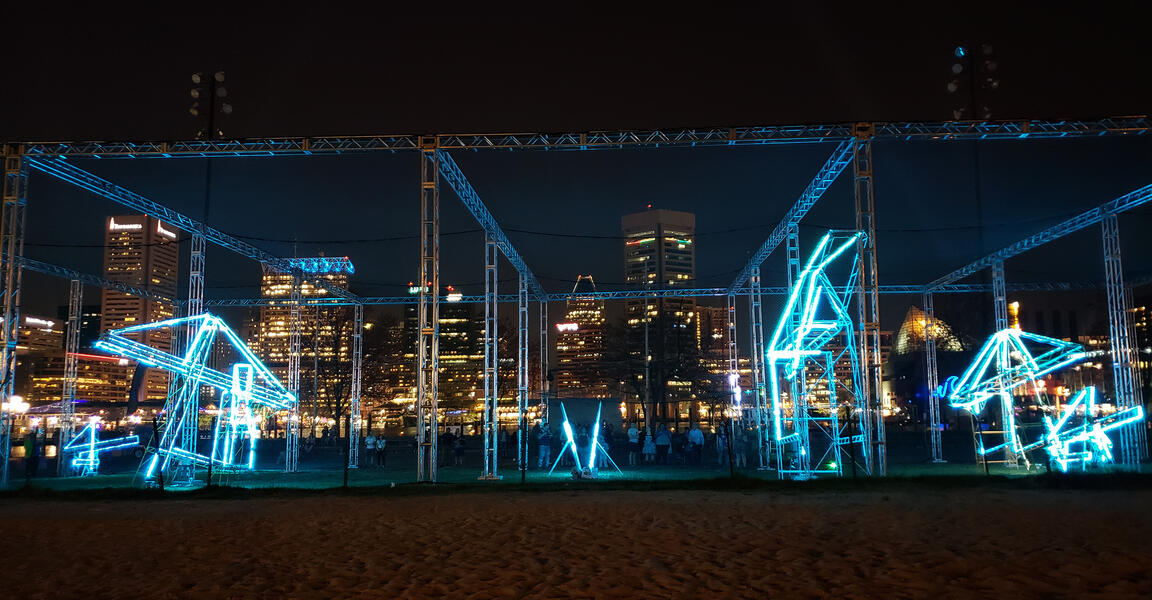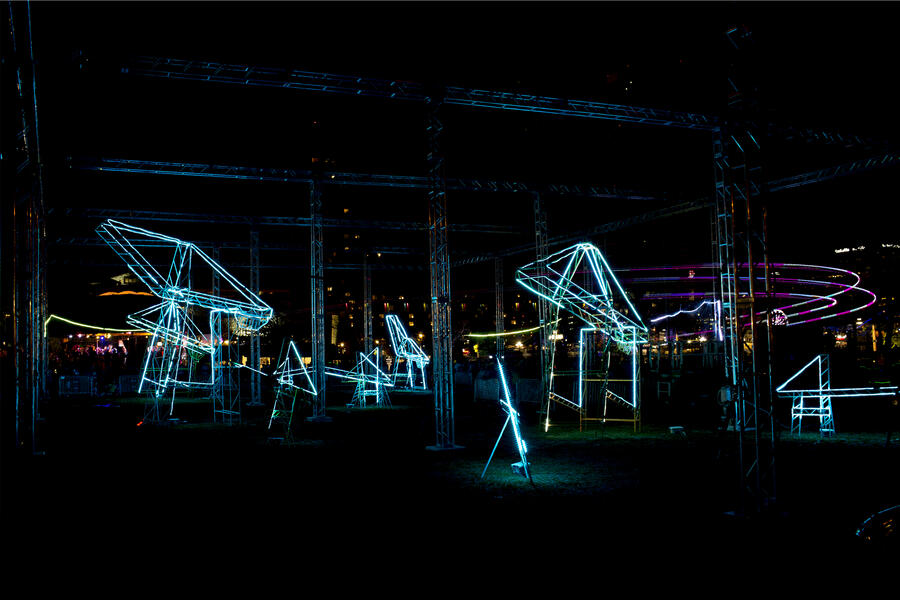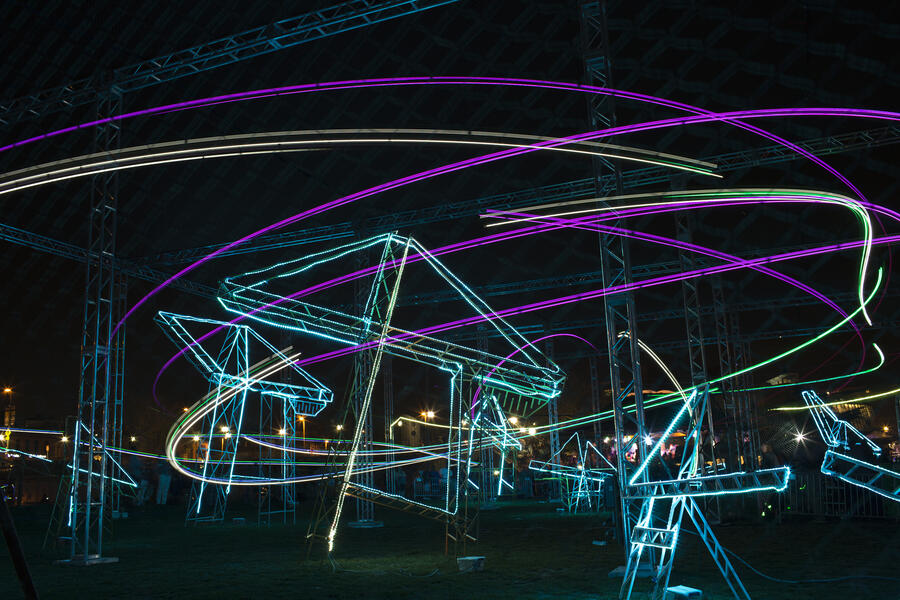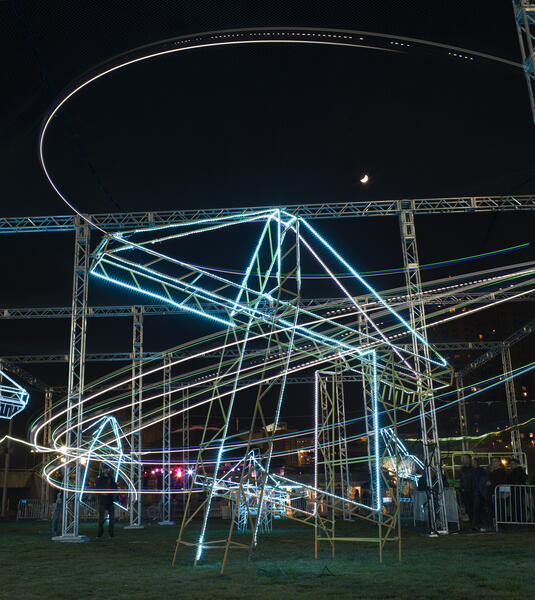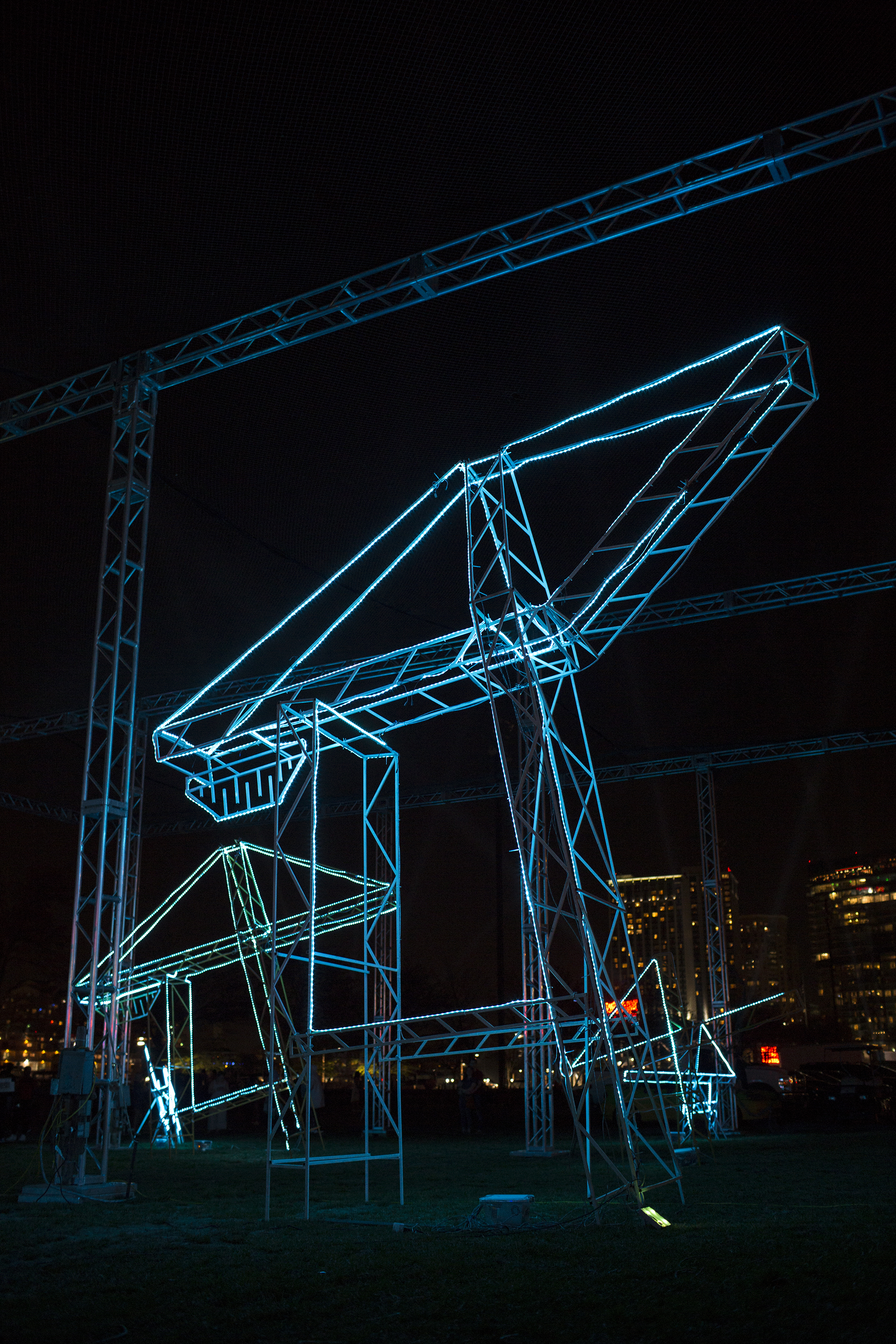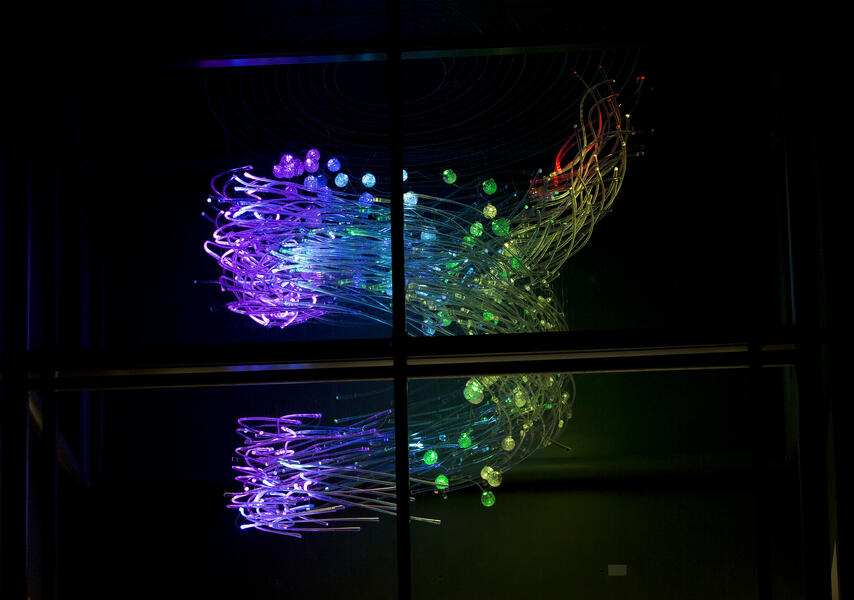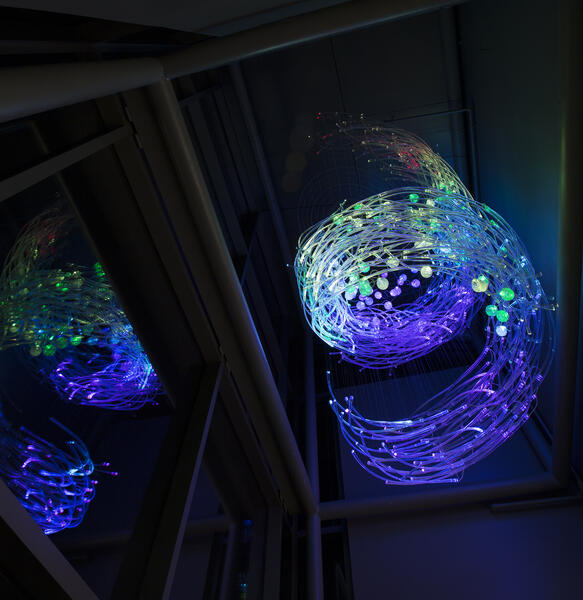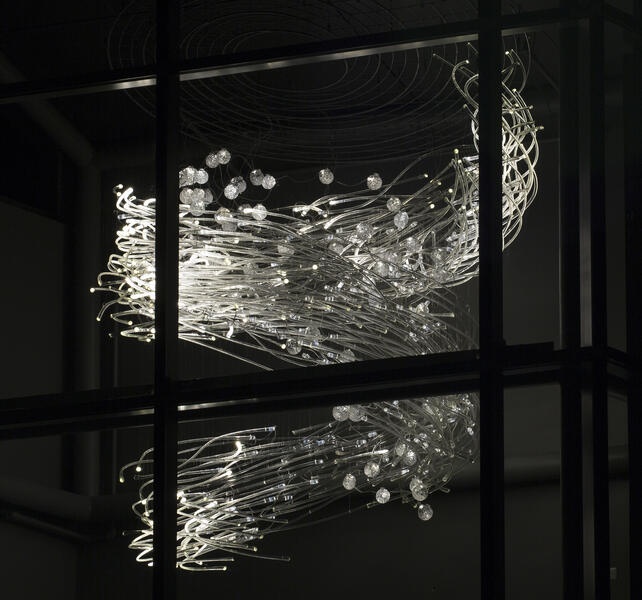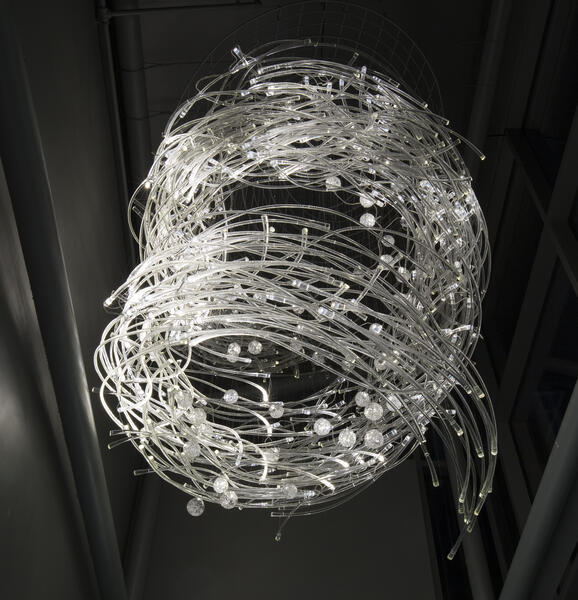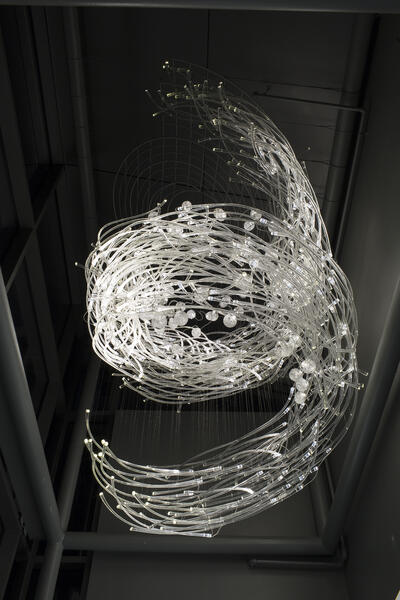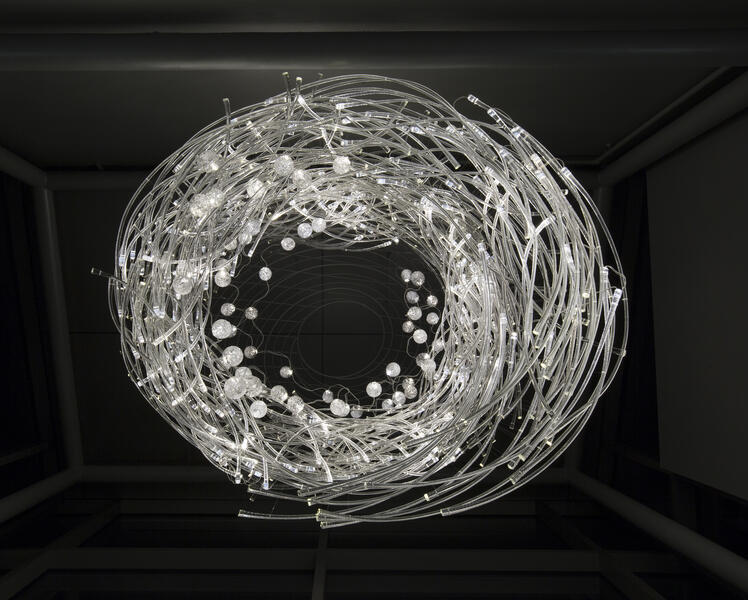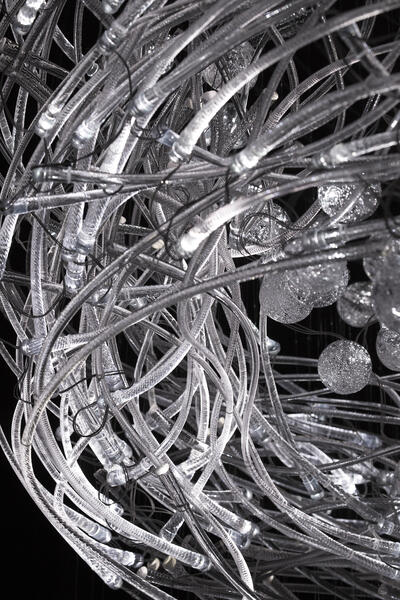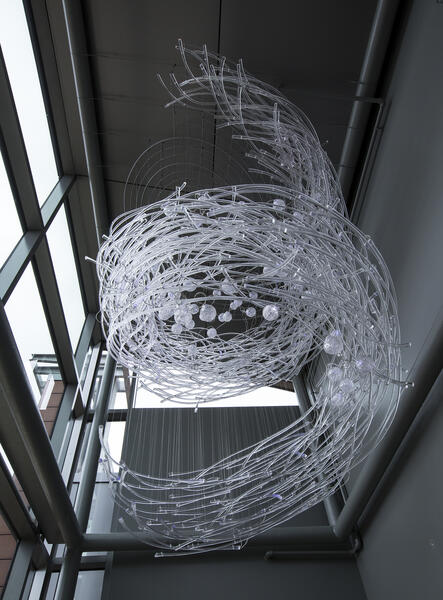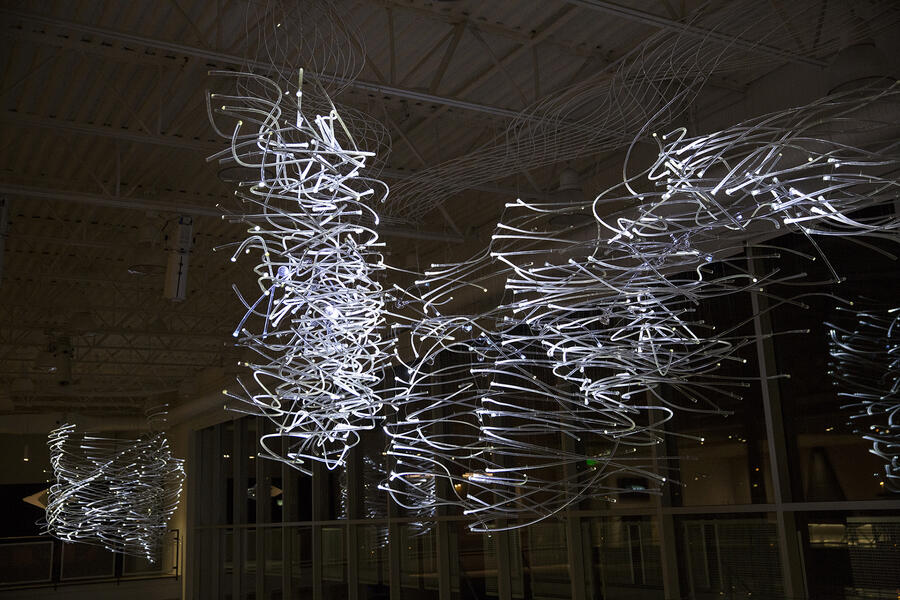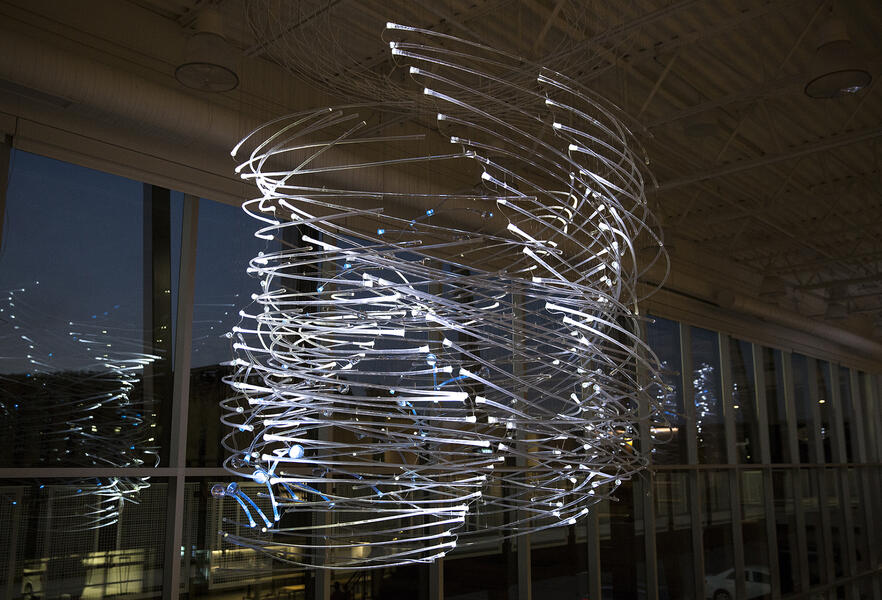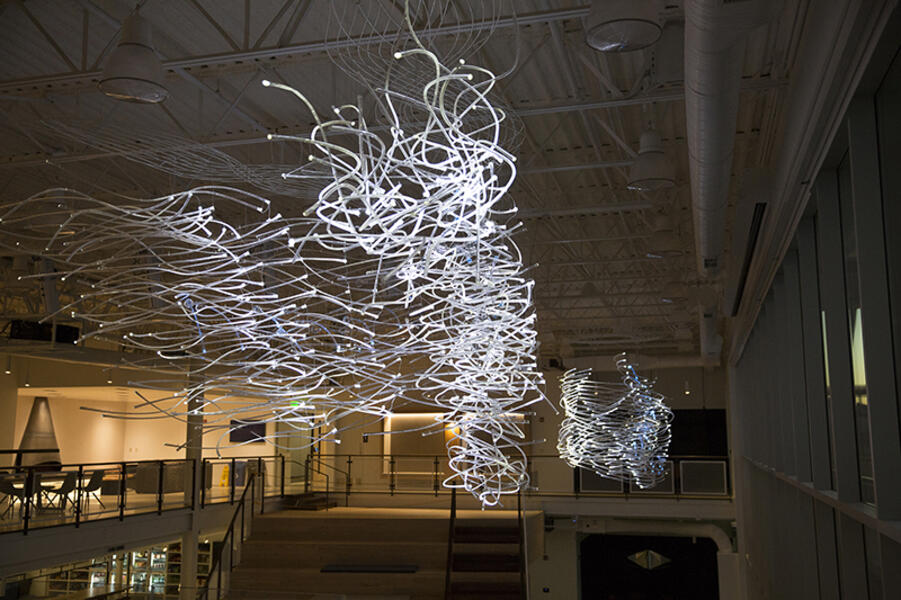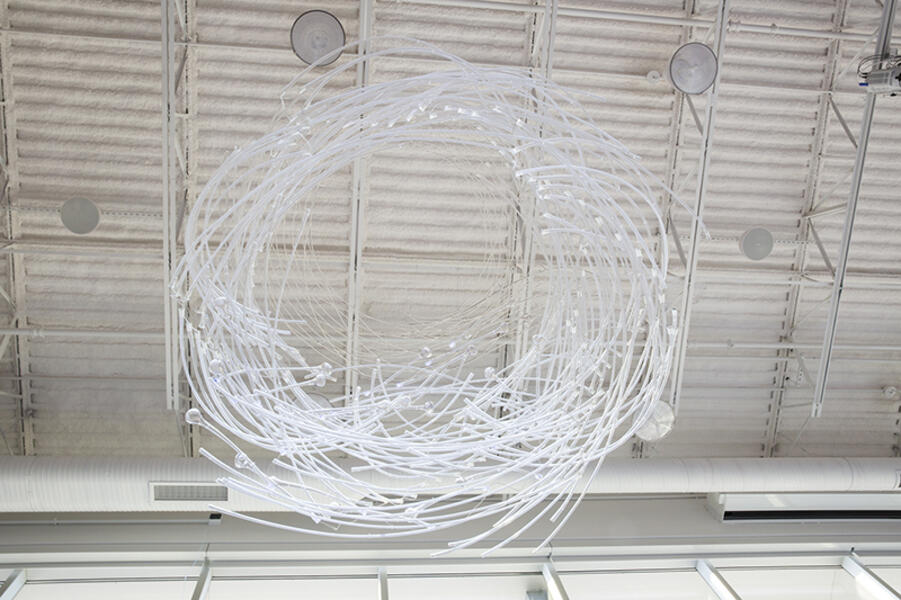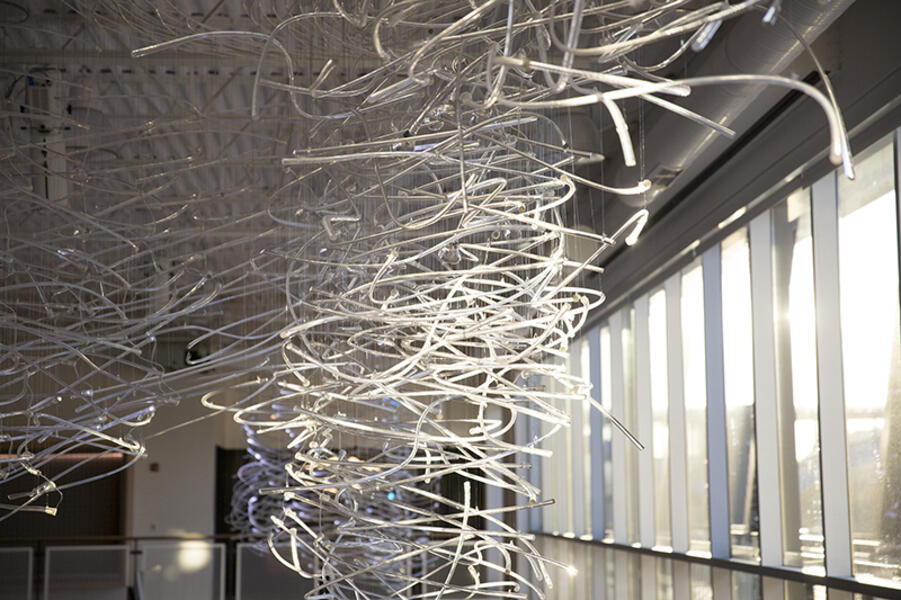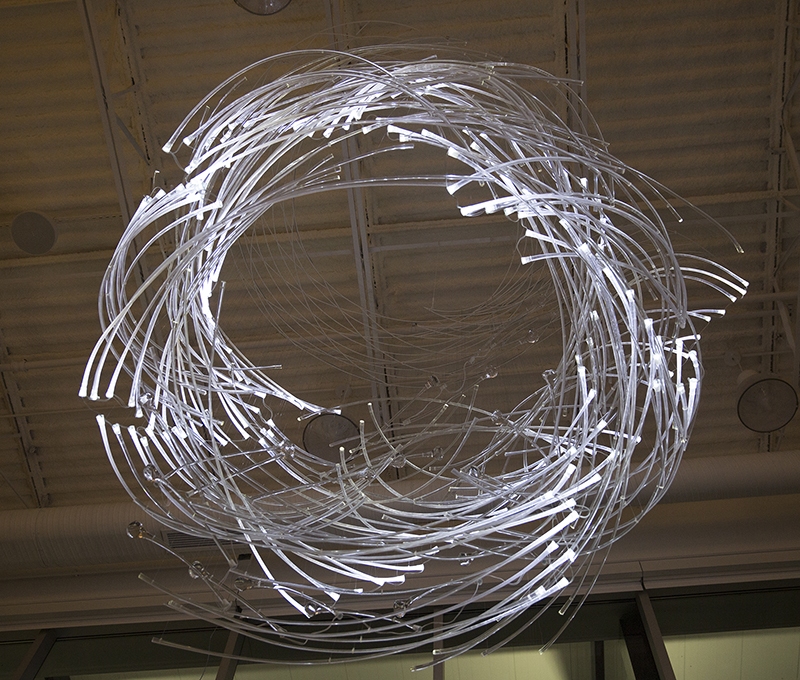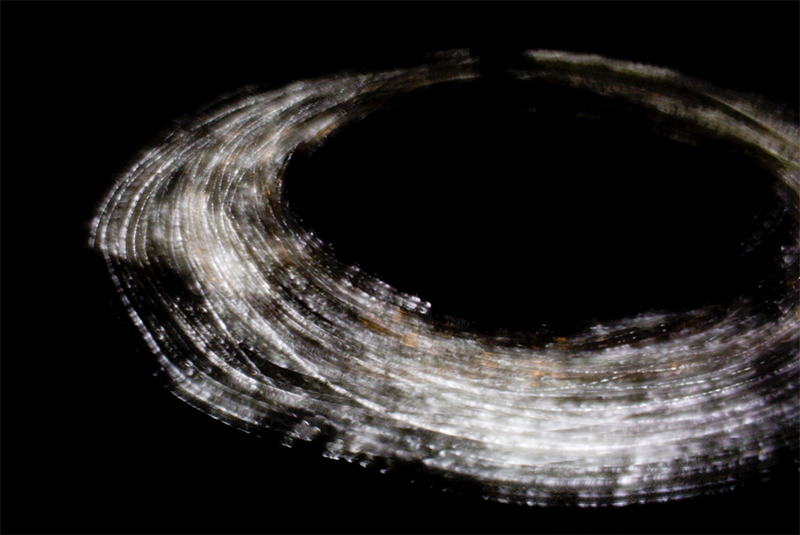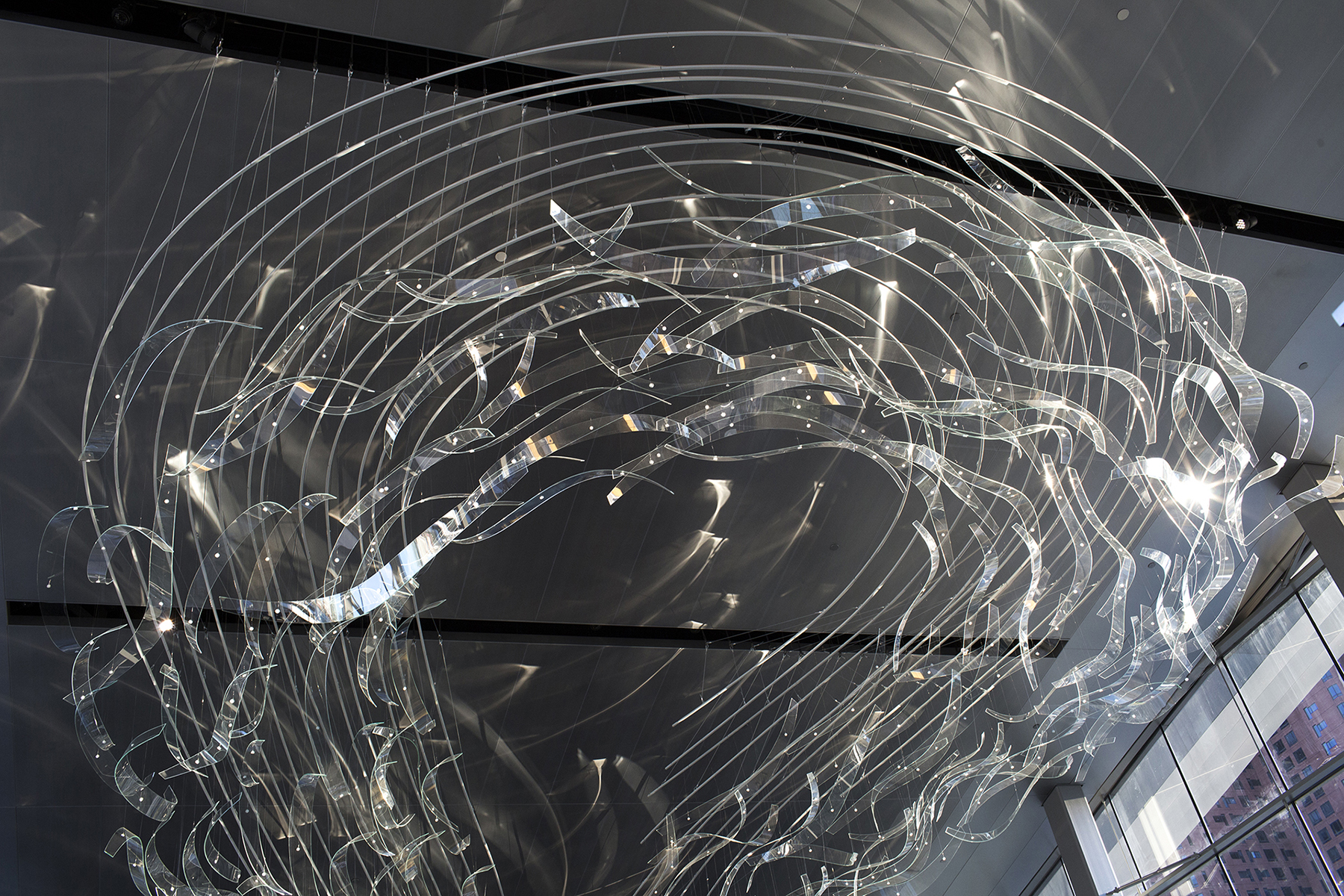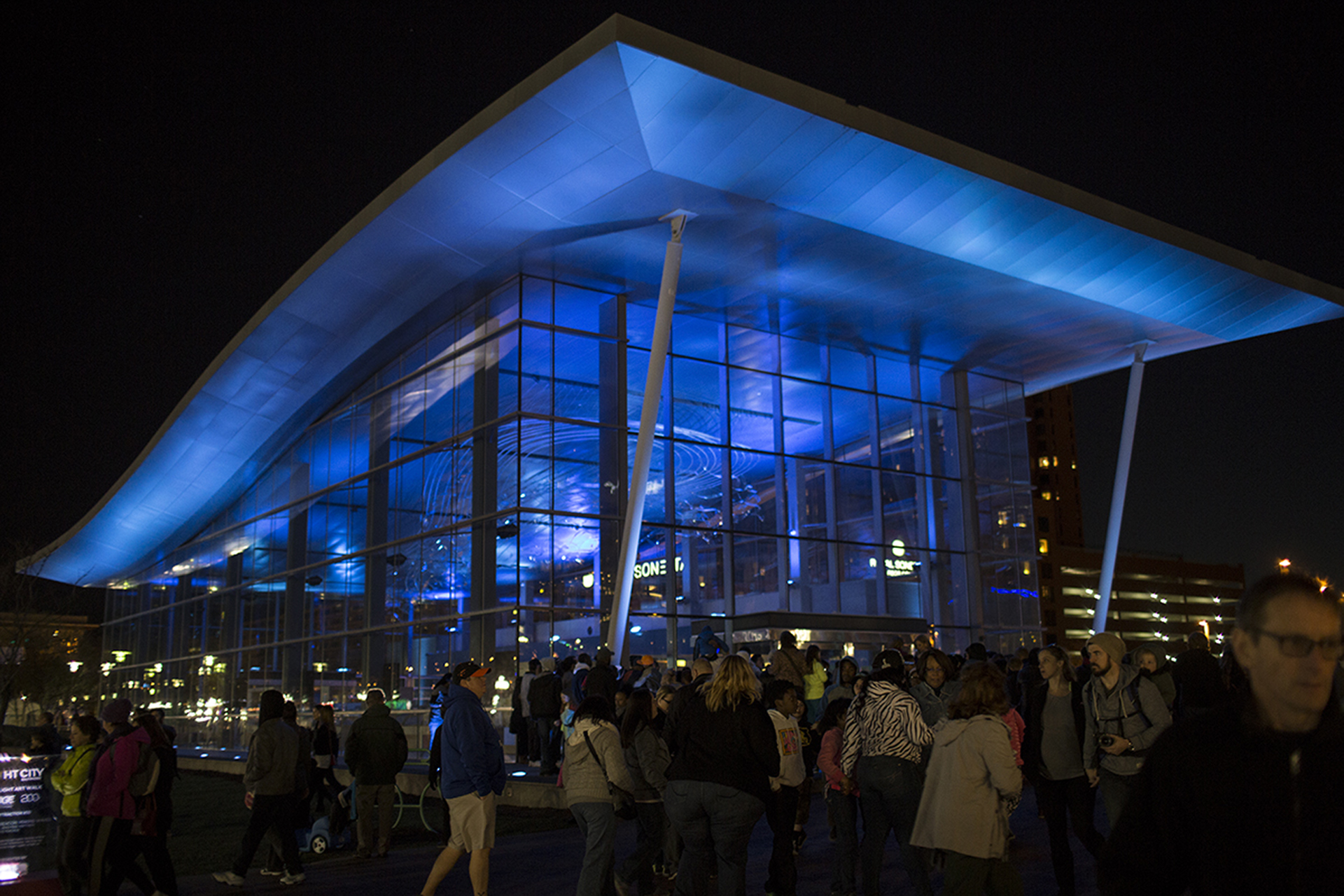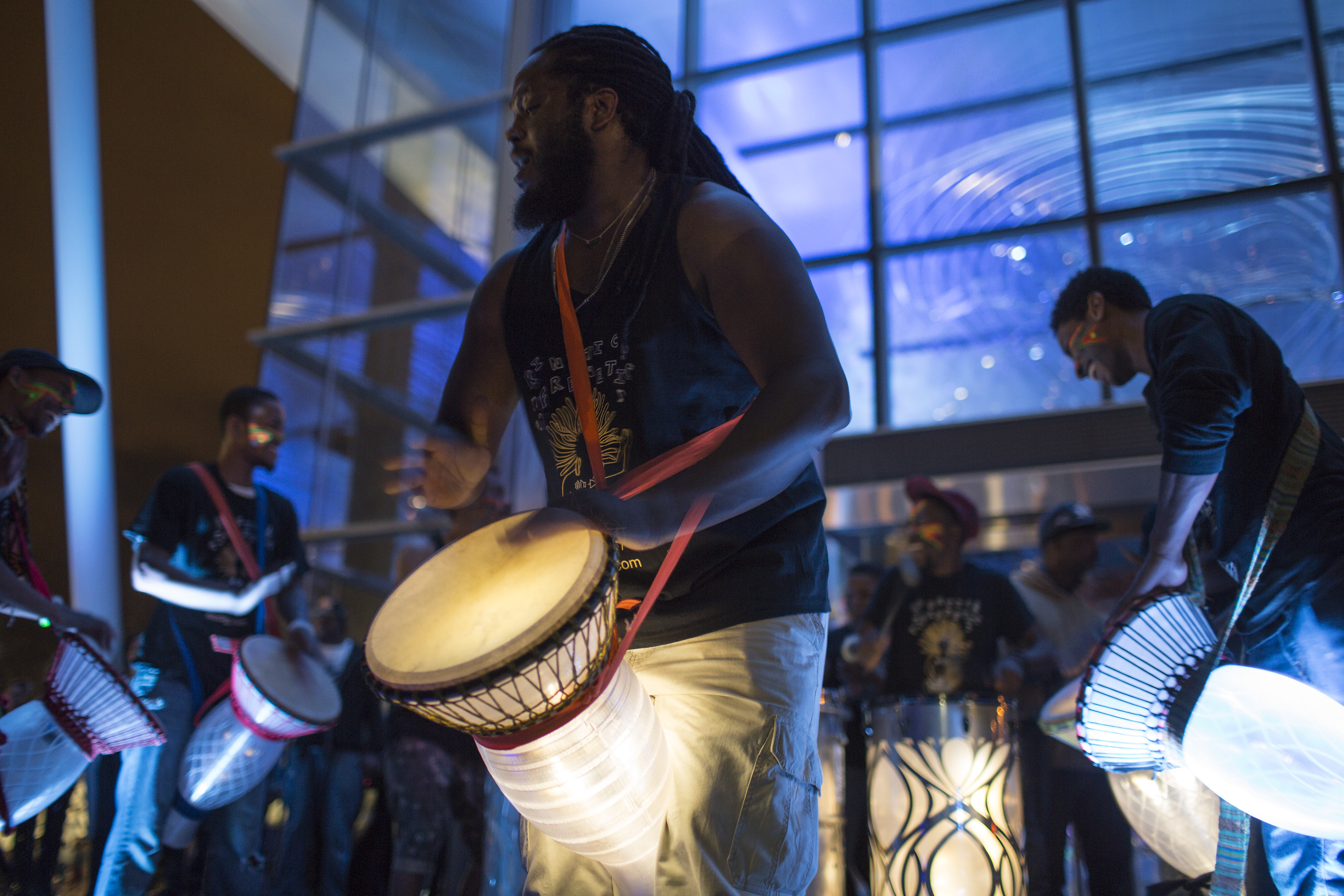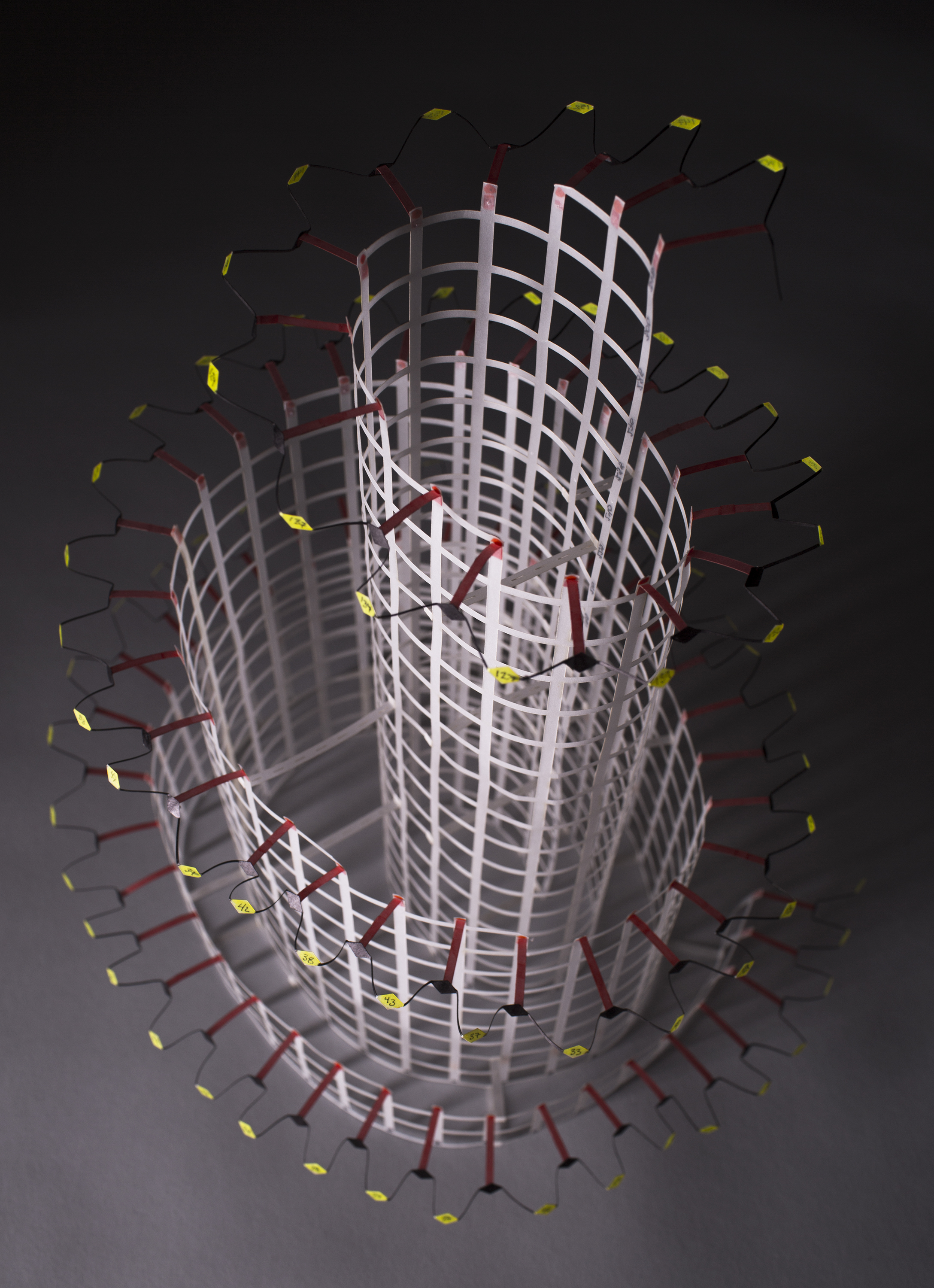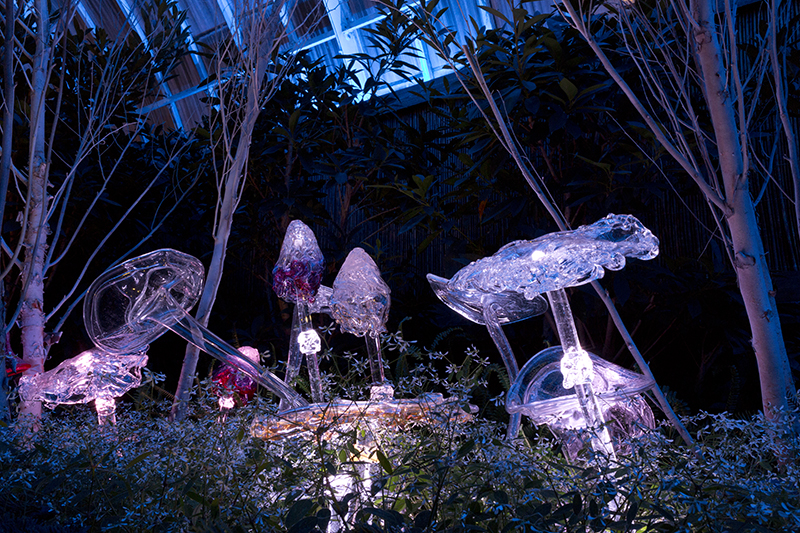Work samples
-
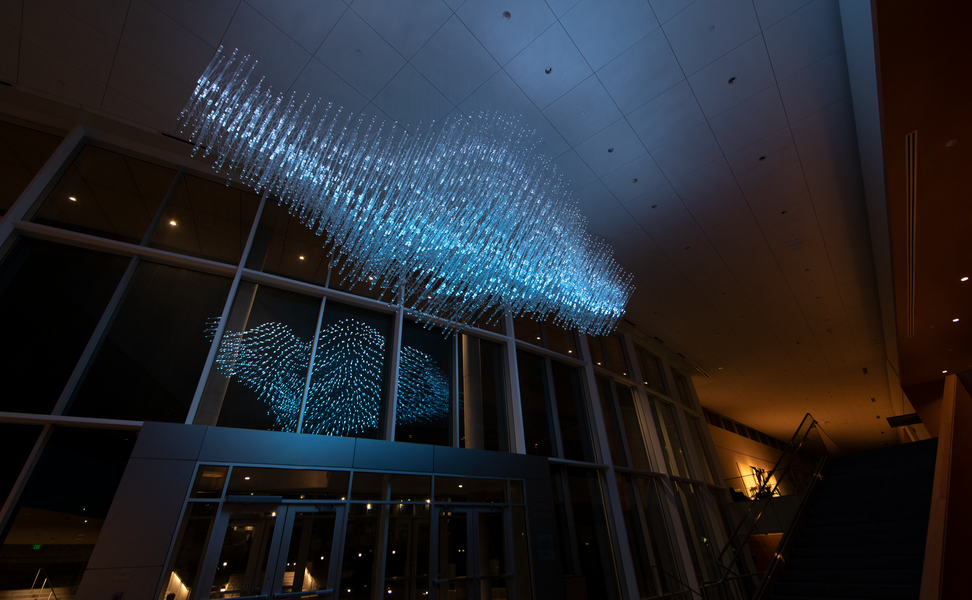 Virga First Floor View_0.png
Virga First Floor View_0.pngVirga, 2018 16' from ceiling x 30' wide x 14' deep Handmade glass, stainless steel wire, 3D printed PET, LEDs, steel armature, custom programming Noorda Center for the Performing Arts Commissioned by the State of Utah, Division of Arts and Museums Virga: Latin meaning ‘rod’, ‘stripe’, ‘branch’. 1. (meteorology) A streak of rain or snow that is dissipated in falling and does not reach the ground, commonly appearing descending from a cloud layer. 2. (music) A type of note used in plainsong notation, having a tail. 3. (measurement) A unit of length: a rod, pole or perch. Our site-specific sculpture Virga is inspired by the complex natural phenomenon of light and water vapor and the gestural ridge lines of the Wasatch Range. In meteorology, virga is a shaft of precipitation that falls from a cloud but evaporates before reaching the ground. This observable phenomenon bends light via water particles, appearing as a streak in the sky suggesting rain. At high altitudes the precipitation falls mainly as ice crystals before melting and finally evaporating. Our sculpture aesthetically responds to these clouds that are often visible floating over Utah Valley. Virga is created with 1650 individually suspended rods in the form of elongated rain drops. The rhythmic layers of glass create varying areas of density and sparsity to form an ethereal cloud as the lens-like ends catch and bend light. Virga is a physically dynamic work, appearing differently depending on the audience’s viewpoint. As the viewer shifts position from outside and within the lobby, the droplets seem as if organized in a linear formation from below and present a complex moiré pattern from the sides and the balconies. Virga is a semi-transparent shifting spectacle that transforms with the changing light of the day. During the daylight hours the glass is the dominant material, reflecting the natural light through the windows. In the early morning sunrise and throughout the evening, the programmable and individually controllable LED lighting is most visible, offering another opportunity for visual transformation. Virga’s custom lighting program transforms real time environmental data drawn from high-elevation weather stations. Data points include wind speed and direction, cloud cover, humidity, precipitation, and temperature, among others, that recreate the cloud conditions in light. Each day, the sunrise and sunset are emulated and extended in light throughout the sculpture, connecting the UVU audience to their environment.
-
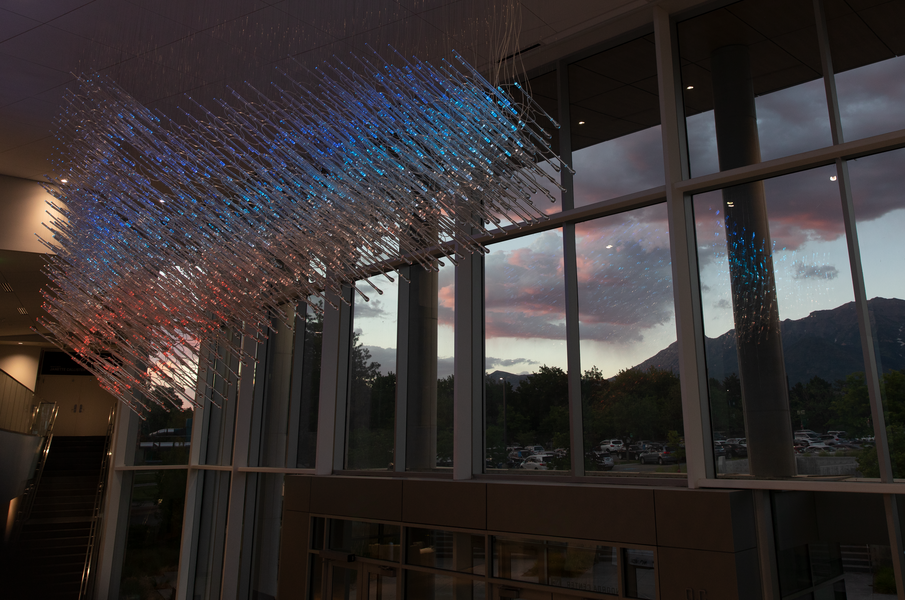 Virga sunset1 _0.png
Virga sunset1 _0.pngVirga, 2018 16' from ceiling x 30' wide x 14' deep Handmade glass, stainless steel wire, 3D printed PET, LEDs, steel armature, custom programming Noorda Center for the Performing Arts Commissioned by the State of Utah, Division of Arts and Museums Virga: Latin meaning ‘rod’, ‘stripe’, ‘branch’. 1. (meteorology) A streak of rain or snow that is dissipated in falling and does not reach the ground, commonly appearing descending from a cloud layer. 2. (music) A type of note used in plainsong notation, having a tail. 3. (measurement) A unit of length: a rod, pole or perch. Our site-specific sculpture Virga is inspired by the complex natural phenomenon of light and water vapor and the gestural ridge lines of the Wasatch Range. In meteorology, virga is a shaft of precipitation that falls from a cloud but evaporates before reaching the ground. This observable phenomenon bends light via water particles, appearing as a streak in the sky suggesting rain. At high altitudes the precipitation falls mainly as ice crystals before melting and finally evaporating. Our sculpture aesthetically responds to these clouds that are often visible floating over Utah Valley. Virga is created with 1650 individually suspended rods in the form of elongated rain drops. The rhythmic layers of glass create varying areas of density and sparsity to form an ethereal cloud as the lens-like ends catch and bend light. Virga is a physically dynamic work, appearing differently depending on the audience’s viewpoint. As the viewer shifts position from outside and within the lobby, the droplets seem as if organized in a linear formation from below and present a complex moiré pattern from the sides and the balconies. Virga is a semi-transparent shifting spectacle that transforms with the changing light of the day. During the daylight hours the glass is the dominant material, reflecting the natural light through the windows. In the early morning sunrise and throughout the evening, the programmable and individually controllable LED lighting is most visible, offering another opportunity for visual transformation. Virga’s custom lighting program transforms real time environmental data drawn from high-elevation weather stations. Data points include wind speed and direction, cloud cover, humidity, precipitation, and temperature, among others, that recreate the cloud conditions in light. Each day, the sunrise and sunset are emulated and extended in light throughout the sculpture, connecting the UVU audience to their environment.
-
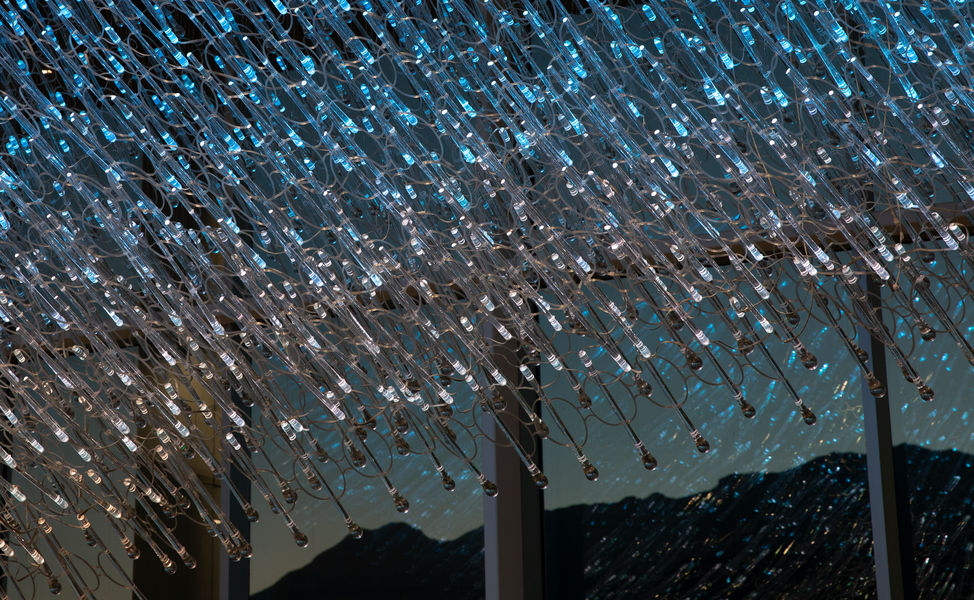 Virga Detail 1 _0.png
Virga Detail 1 _0.pngVirga, 2018 16' from ceiling x 30' wide x 14' deep Handmade glass, stainless steel wire, 3D printed PET, LEDs, steel armature, custom programming Noorda Center for the Performing Arts Commissioned by the State of Utah, Division of Arts and Museums Virga: Latin meaning ‘rod’, ‘stripe’, ‘branch’. 1. (meteorology) A streak of rain or snow that is dissipated in falling and does not reach the ground, commonly appearing descending from a cloud layer. 2. (music) A type of note used in plainsong notation, having a tail. 3. (measurement) A unit of length: a rod, pole or perch. Our site-specific sculpture Virga is inspired by the complex natural phenomenon of light and water vapor and the gestural ridge lines of the Wasatch Range. In meteorology, virga is a shaft of precipitation that falls from a cloud but evaporates before reaching the ground. This observable phenomenon bends light via water particles, appearing as a streak in the sky suggesting rain. At high altitudes the precipitation falls mainly as ice crystals before melting and finally evaporating. Our sculpture aesthetically responds to these clouds that are often visible floating over Utah Valley. Virga is created with 1650 individually suspended rods in the form of elongated rain drops. The rhythmic layers of glass create varying areas of density and sparsity to form an ethereal cloud as the lens-like ends catch and bend light. Virga is a physically dynamic work, appearing differently depending on the audience’s viewpoint. As the viewer shifts position from outside and within the lobby, the droplets seem as if organized in a linear formation from below and present a complex moiré pattern from the sides and the balconies. Virga is a semi-transparent shifting spectacle that transforms with the changing light of the day. During the daylight hours the glass is the dominant material, reflecting the natural light through the windows. In the early morning sunrise and throughout the evening, the programmable and individually controllable LED lighting is most visible, offering another opportunity for visual transformation. Virga’s custom lighting program transforms real time environmental data drawn from high-elevation weather stations. Data points include wind speed and direction, cloud cover, humidity, precipitation, and temperature, among others, that recreate the cloud conditions in light. Each day, the sunrise and sunset are emulated and extended in light throughout the sculpture, connecting the UVU audience to their environment.
-
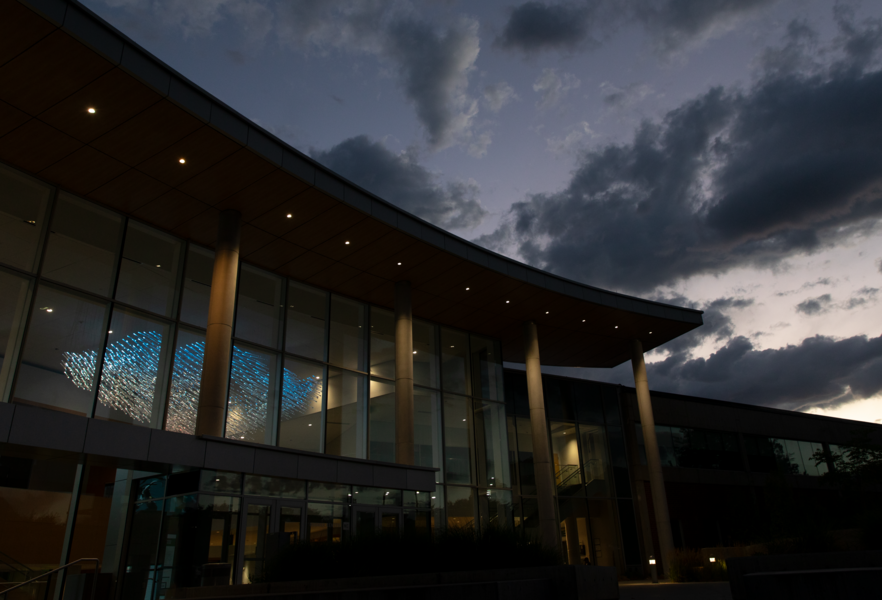 Virga Exterior Sunset1_0.png
Virga Exterior Sunset1_0.pngVirga, 2018 16' from ceiling x 30' wide x 14' deep Handmade glass, stainless steel wire, 3D printed PET, LEDs, steel armature, custom programming Noorda Center for the Performing Arts Commissioned by the State of Utah, Division of Arts and Museums Virga: Latin meaning ‘rod’, ‘stripe’, ‘branch’. 1. (meteorology) A streak of rain or snow that is dissipated in falling and does not reach the ground, commonly appearing descending from a cloud layer. 2. (music) A type of note used in plainsong notation, having a tail. 3. (measurement) A unit of length: a rod, pole or perch. Our site-specific sculpture Virga is inspired by the complex natural phenomenon of light and water vapor and the gestural ridge lines of the Wasatch Range. In meteorology, virga is a shaft of precipitation that falls from a cloud but evaporates before reaching the ground. This observable phenomenon bends light via water particles, appearing as a streak in the sky suggesting rain. At high altitudes the precipitation falls mainly as ice crystals before melting and finally evaporating. Our sculpture aesthetically responds to these clouds that are often visible floating over Utah Valley. Virga is created with 1650 individually suspended rods in the form of elongated rain drops. The rhythmic layers of glass create varying areas of density and sparsity to form an ethereal cloud as the lens-like ends catch and bend light. Virga is a physically dynamic work, appearing differently depending on the audience’s viewpoint. As the viewer shifts position from outside and within the lobby, the droplets seem as if organized in a linear formation from below and present a complex moiré pattern from the sides and the balconies. Virga is a semi-transparent shifting spectacle that transforms with the changing light of the day. During the daylight hours the glass is the dominant material, reflecting the natural light through the windows. In the early morning sunrise and throughout the evening, the programmable and individually controllable LED lighting is most visible, offering another opportunity for visual transformation. Virga’s custom lighting program transforms real time environmental data drawn from high-elevation weather stations. Data points include wind speed and direction, cloud cover, humidity, precipitation, and temperature, among others, that recreate the cloud conditions in light. Each day, the sunrise and sunset are emulated and extended in light throughout the sculpture, connecting the UVU audience to their environment.
About McCormack and Figg

Jenn Figg and Matthew McCormack are collaborative, interdisciplinary artist-researchers investigating light energy and universal geometries. Our backgrounds are rooted in the material experiences and craft methodologies of textiles and glass. While we identify our creative heritage with the feminist fibers movement of the 1960’s and the American Studio Glass movement respectively, we draw directly from a myriad of inspirational sources beyond the… more
Light Pressure
Hot worked mica infused clear glass canes, cut plate glass, LEDs, 3D printed PET, stainless steel, stainless steel wire, computer system, custom programming
18’ high from the ceiling, 3.5’ in diameter at the widest point, 100’ long
Permanent installation at the Fascitelli Center for Advanced Engineering, College of Engineering, University of Rhode Island, Kingston, Rhode Island
Commissioned by the Rhode Island State Council on the Arts and University of Rhode Island
Light Pressure is a visual narrative that conflates mechanical, electrical, and optical phenomena, specifically blending pressure and fluid dynamics with the visuality of collimated light and force fields. Traveling down the corridor, a gestural vortex gives way to a linear flow of light encircled with curving glass and planar sheets, referencing magnetic fields, turbine blades, and supercavitation.
Light Pressure is created with suspended glass rods and curved canes. The rhythmic layers of glass create varying areas of density and sparsity to form an energetic, gently curving beam as the lens-like ends catch and bend light. Light Pressure is a site specific work, appearing differently depending on the audience’s viewpoint and time of day. Hand made from clear glass with embedded mica flakes to reflect and refract light, Light Pressure is semi-transparent and sparkling. In this way, Light Pressure is a shifting spectacle, while also receding into the architecture to become almost invisible.
At night the sculpture comes alive with dynamic custom lighting. Local tide and temperature data forms a basis of the machine-learning program, creating pulsing, sweeping, and spiraling patterns of shifting chroma and luminosity across the 1600 dimensionally mapped LEDs. This light is reflected off the interior glass wall and exterior curtain wall, creating an immersive feeling of deep waves and sparkling current as light pulses travel along the length of the sculpture.
-
 Light Pressure
Light PressureLight Pressure, daytime view. No illumination.
-
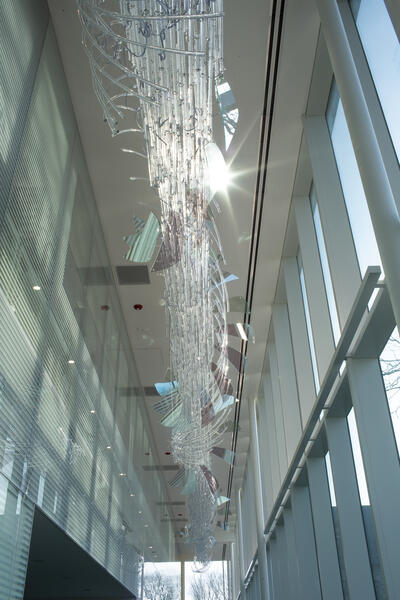 Light Pressure
Light PressureLight Pressure, daytime view from below.
-
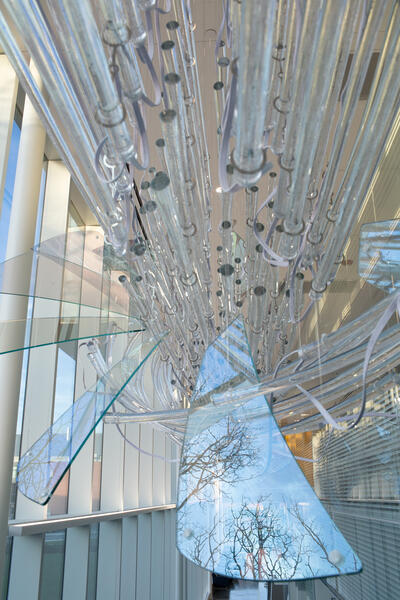 Light Pressure
Light PressureDetail view of Light Pressure, specifically the plate glass blades.
-
 Light Pressure
Light PressureLight Pressure, detail view of handmade glass canes with embedded mica, daytime.
-
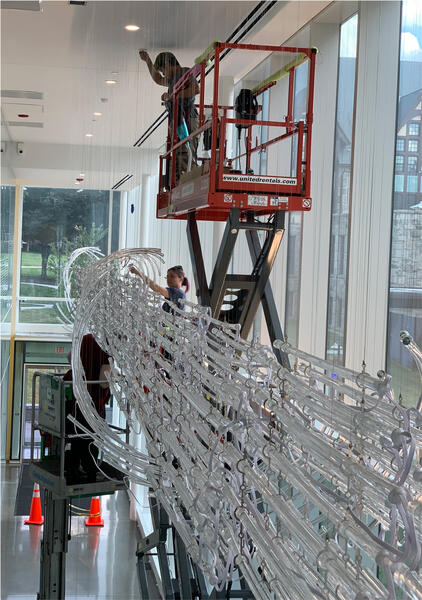 Light Pressure, installation
Light Pressure, installationLight Pressure installation process image. With gratitude to Eka, Sioban, and Giftilyn for their energy and support.
-
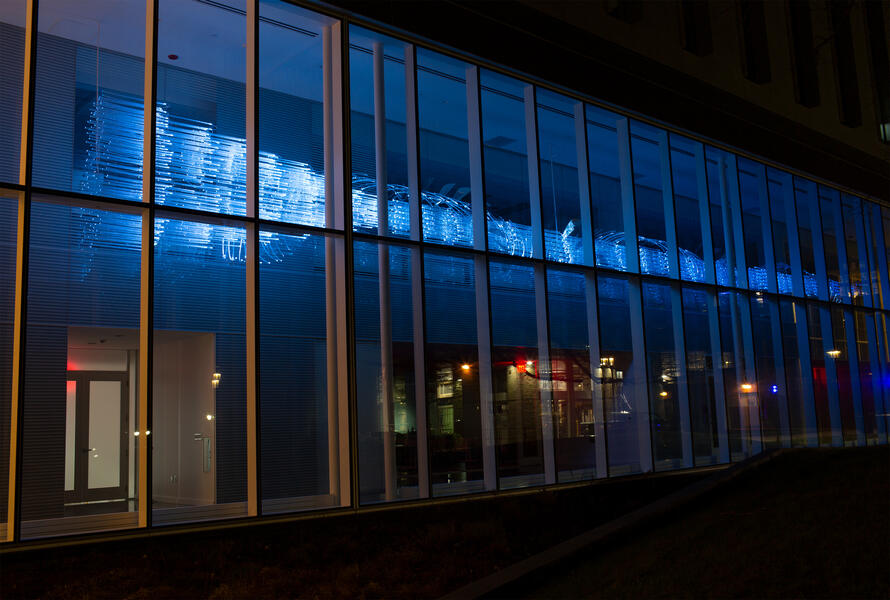 Light Pressure
Light PressureNighttime exterior view of Light Pressure, full illuminated sculpture.
-
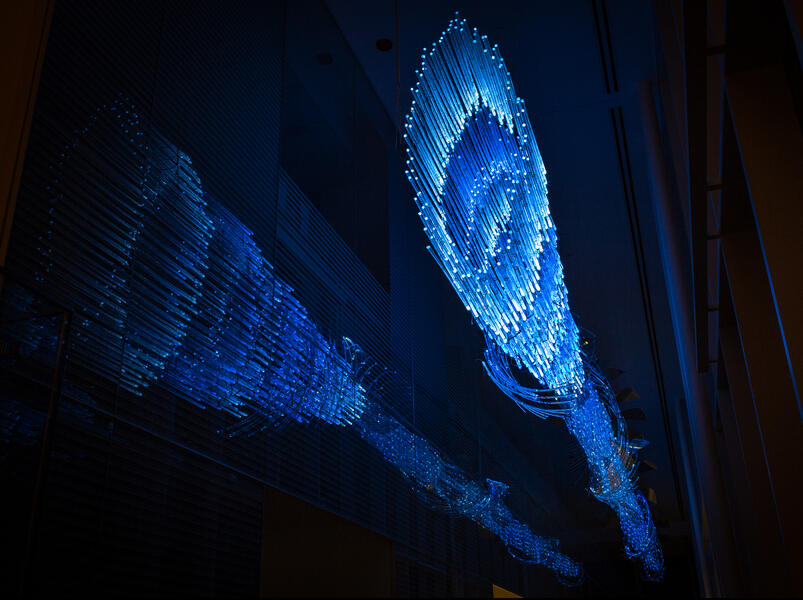 Light Pressure
Light PressureLight Pressure, interior view at night and reflection on the glass wall. Illuminated.
-
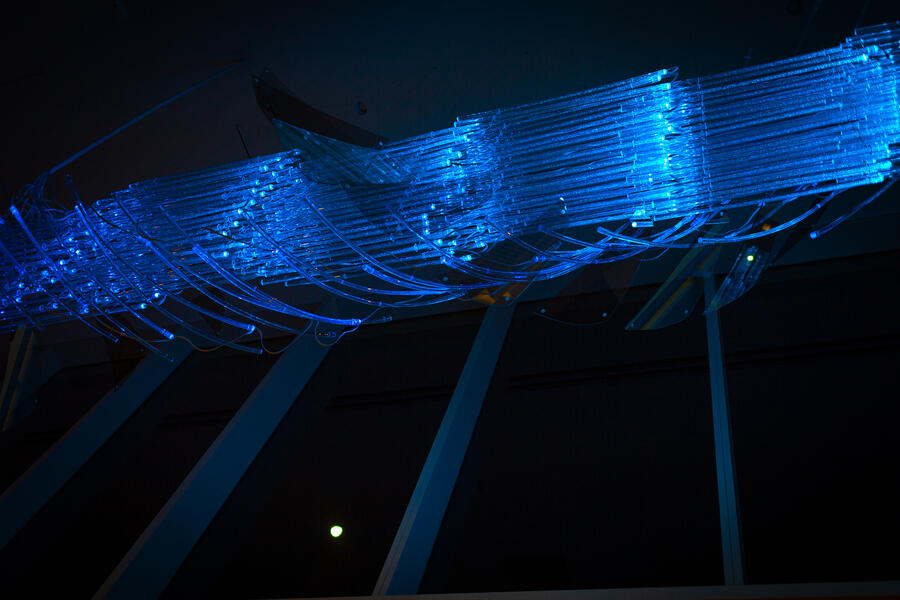 Light Pressure
Light PressureLight Pressure, view of the tail from below at night, illuminated.
-
 Light Pressure
Light PressureLight Pressure, view of the shock cone from below at night, illuminated.
Off the Rails
Dimensions variable, 10' high, 5' wide x 7' long.
Pulled glass gold ruby twisted cane, 3D printed plastic, LEDs, custom lighting program, wire.
Off the Rails is a rollercoaster based on our ongoing obsessions: wooden lattices and truss systems, entropy, and installation sculpture. The illuminated flashiness of carnival lights draw us in towards the horror of impossibly banked turns and a broken, failing track. The candy like, gold ruby twisty cane is informed by gilded decadence, while the broken track considers a deserted amusement park, where economic imperatives has made disinvestment more profitable than maintenance. The crumbling infrastructure correlates to a vision of our current political landscape, where compassion and forward thinking has been abandoned for greed and isolationism. Crows are scavenging broken pieces of glass, and flying towards an unknown future. It is a frightening ride going off the rails.
Transference
Convergence
Kinetic Light Instruments and their traces
Real-time visualization of energy is a driving theme in our collaborative research project, Human Interaction, Energy Harvesting, and Lumia. We are inspired by László Moholy-Nagy’s light play, specifically, Lichtspiele, that creates “a light-space-time continuity in the synthesis of motion.” Our Kinetic Light Instruments function similarly and are a futuristic extension of these fundamental ideas with the added focus of human energy harvesting. These techno-cultural reimagined objects are inspired by traditional instruments, including seed shakers and rainsticks. In the shakers and rattles, we construct unique piezo wiring harnesses to demonstrate complex energy relationships. Kinetic Light Instruments are interactive, sensorial sculptures that connect performers and audiences in a new way with human generated light by merging the materials of light and sound, directly connecting these phenomena with movements of the body.
We create instruments and objects that harness human-generated kinetic energy to sustain connection, communication, and creativity, as conduits for participants to project their own energy out as light. This real time visualization of energy is a reminder of the power we each possess to create positive change and beauty in the world.
-
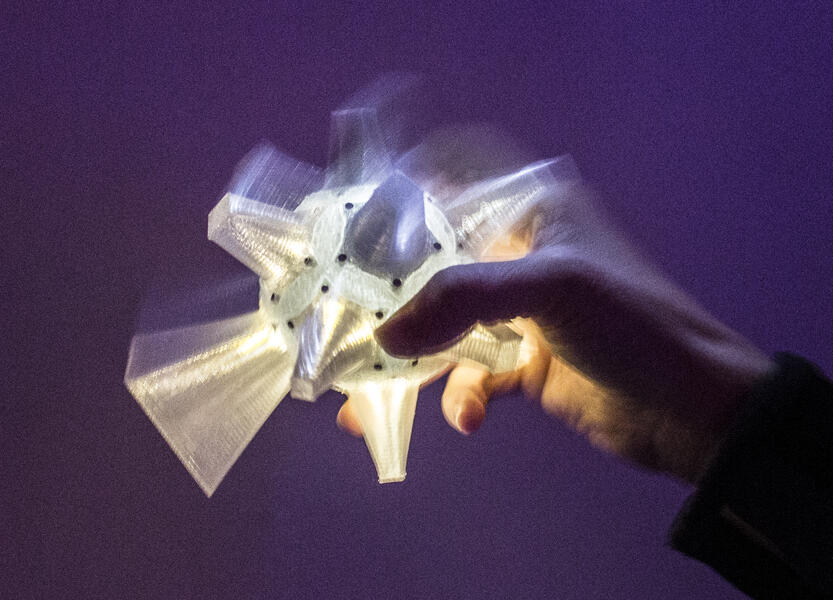 Satellite Skaker3D printed parts, LEDs, piezos, hardware 2017 Edition of 3
Satellite Skaker3D printed parts, LEDs, piezos, hardware 2017 Edition of 3 -
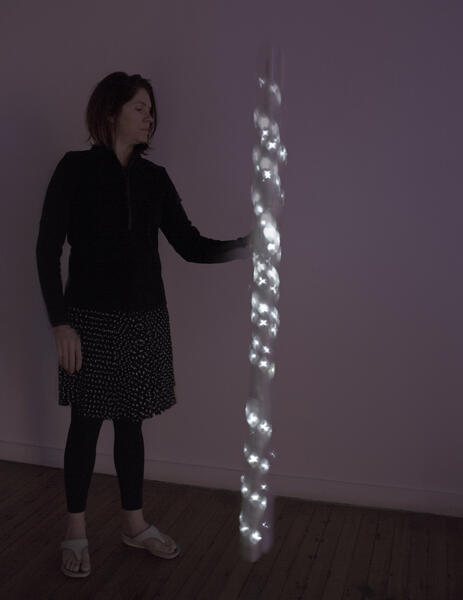 Rainstick3D printed parts, piezos, LEDs, hardware 2017 Edition of 1
Rainstick3D printed parts, piezos, LEDs, hardware 2017 Edition of 1 -
Piezo Powered IR ShakerWhen shaken, this instrument generates power for an infrared LED with a piezo energy harvesting cube. An small camera with an infrared filter captures the light.
-
Seed ShakersInspired by traditional seed instrument, these 3D printed shakers generate bright light when played. Energy is harvested by the percussive actions, lighting up LEDs.
-
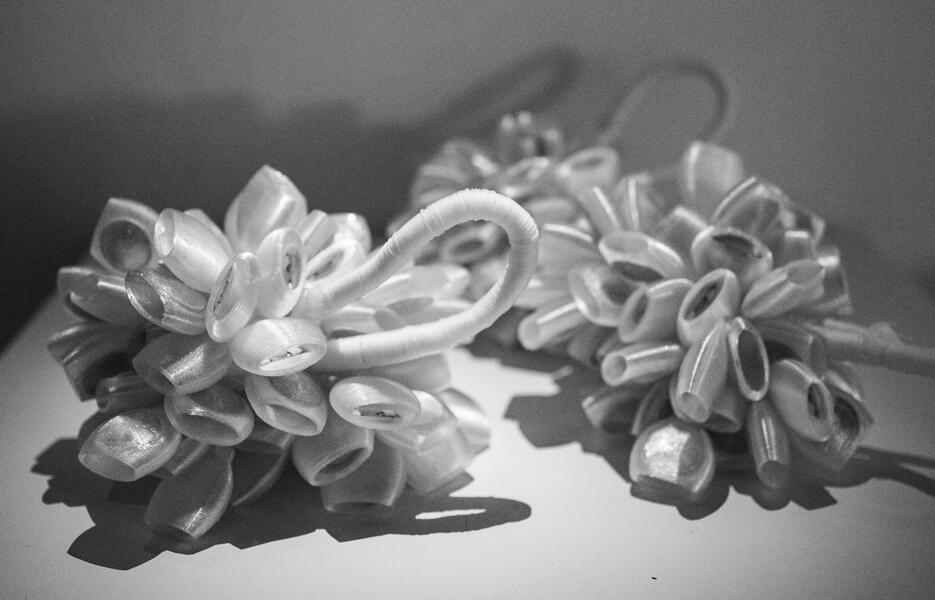 Seed ShakersSeed Shaker Kinetic Light Instruments 3D printed plastic, LEDs, Piezos, String 2017 Edition of 3
Seed ShakersSeed Shaker Kinetic Light Instruments 3D printed plastic, LEDs, Piezos, String 2017 Edition of 3 -
KickballEnergy harvesting cubes power up LEDs with every bounce and roll in this flexible 3D printed flower ball.
-
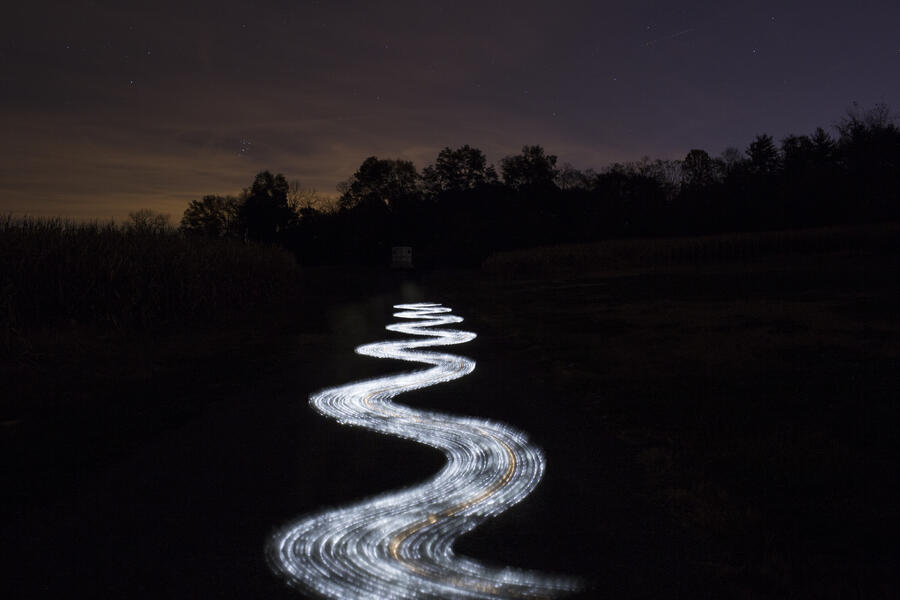 Luminescent Anthologies 52014 Framed Digital Archival Print, 36" x 48" The big dipper is visible in the luminous, dusky purple night sky above the reflected light pollution of Baltimore. A river of light is generated by the kinetic light rake sculpture. As the rake is dragged along a rural road, the piezo elements power a linear series of LED lights. A 30 second exposure captures the traces of movement as the rake follows the uneven surface of the pavement.
Luminescent Anthologies 52014 Framed Digital Archival Print, 36" x 48" The big dipper is visible in the luminous, dusky purple night sky above the reflected light pollution of Baltimore. A river of light is generated by the kinetic light rake sculpture. As the rake is dragged along a rural road, the piezo elements power a linear series of LED lights. A 30 second exposure captures the traces of movement as the rake follows the uneven surface of the pavement. -
 Luminescent Anthologies 22014 Framed Archival Digital Print, 36” x 48” A ring of light evoking a galaxy was created by sweeping in a quick circular motion with the kinetic light rake sculpture. The Rake is swept in a gestural semi-circle. As the rake caught and bounced upon the ripples and pebbles in the road bed, more intense points of light were captured in the image.
Luminescent Anthologies 22014 Framed Archival Digital Print, 36” x 48” A ring of light evoking a galaxy was created by sweeping in a quick circular motion with the kinetic light rake sculpture. The Rake is swept in a gestural semi-circle. As the rake caught and bounced upon the ripples and pebbles in the road bed, more intense points of light were captured in the image. -
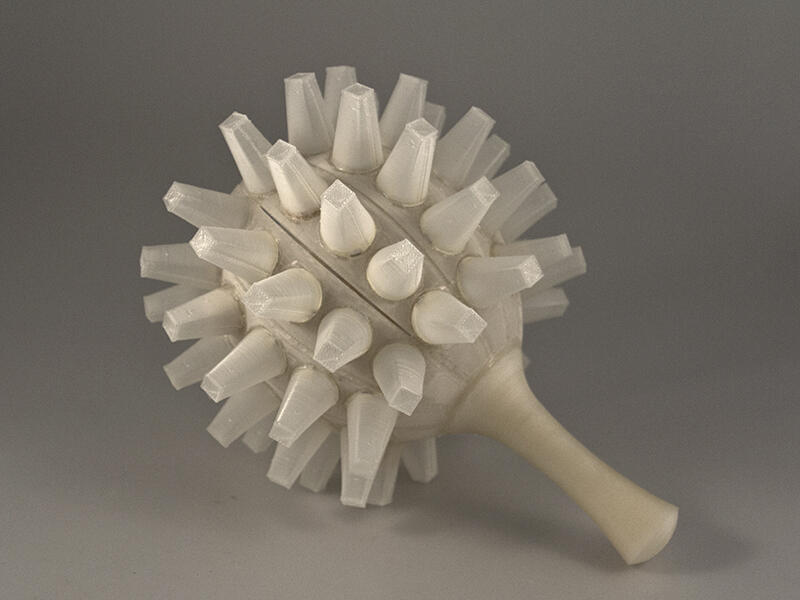 Shekere2014 Printed PLA plastic, bearings, piezo elements, LEDs A sculptural reimagining of a traditional gourd instrument with the addition of human generated light. As this rattle is shaken, small bearings impact piezo elements which convert the vibrations to electricity that powers leds. The light is diffused by the translucent printed plastic. The Shekere is a indirect percussive instrument, informed by historical shekeres made from gourds, string, and beads.
Shekere2014 Printed PLA plastic, bearings, piezo elements, LEDs A sculptural reimagining of a traditional gourd instrument with the addition of human generated light. As this rattle is shaken, small bearings impact piezo elements which convert the vibrations to electricity that powers leds. The light is diffused by the translucent printed plastic. The Shekere is a indirect percussive instrument, informed by historical shekeres made from gourds, string, and beads. -
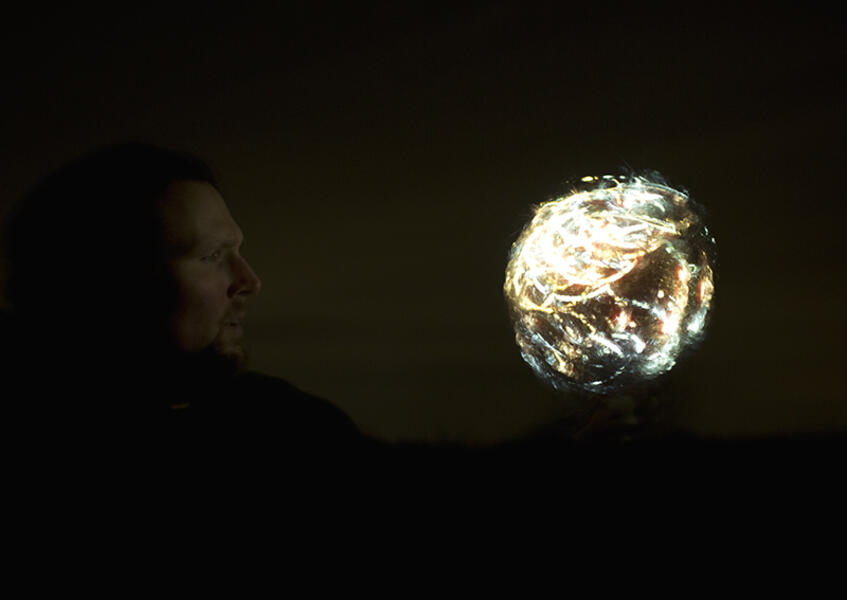 Luminescent Anthologies 12014 Framed Archival Digital Print, 36” x 48” In this image, human energy is transformed into light via technology, imagined as speculative future ritual and ceremony. The glow from the shaken Shekere instrument illuminates the profile of Matthew’s face, reinforcing the interrelated concepts of mysticism, spirit, and creation in the work.
Luminescent Anthologies 12014 Framed Archival Digital Print, 36” x 48” In this image, human energy is transformed into light via technology, imagined as speculative future ritual and ceremony. The glow from the shaken Shekere instrument illuminates the profile of Matthew’s face, reinforcing the interrelated concepts of mysticism, spirit, and creation in the work.
Sea Grass & Community Beacons: Making Waves: Light City 2016
Sea Grass, 2016
12' from ceiling x 80' long x 35' wide
Kiln formed glass, steel, wire, milled polycarbonate.
Site-Specific Permanent Installation in the Baltimore Visitor Center
Inspired by the aquatic grasses of the Chesapeake Bay, the sculpture takes the form of eelgrass as if it swayed with the tides. Always in motion, the glass moves with subtle air currents and reflects light upon the ceiling in dynamic displays during the day.
Sub-aquatic vegetation can be found in the shallow intertidal waters and is a critical part of a healthy Bay ecosystem. The grasses are part of a fragile environment that provides wildlife like the Blue Crab with food and habitat, adds oxygen to the water, absorbs nutrient pollution, traps sediment and reduces erosion. A healthy Chesapeake and Inner Harbor vibrant with the arts are cultural identifiers and supports a healthy Baltimore community, one that is in a symbiotic relationship with the Harbor.
-AND-Community Beacons: Making Waves
Kinetic Frenetic (A Collaboration with Jenn Figg, Matthew McCormack, and David Fakunle)
Performers include David Fakunle, Duane Hinton, Jahi Jelani, Brova Tobias, Jabari Jefferson,
Themba Sipho Mkhatshwa, Frank Holliday, Charles Watson, and Zakiya Jefferson.
Community Beacons: Making Waves was a community-based and community-driven participatory percussion project fusing the combined forces of sound and light to activate individuals' energies toward positive social transformation. Making Waves was a marriage of ancient tradition and innovative technology using performance and custom kinetic instruments that illuminated a local landmark - the Baltimore Visitor Center - with waves of dynamic light.
With percussive sounds unique to Baltimore, performers played a blend of traditional African rhythms in combination with beats popularized in Baltimore's clubs. Organized performances dovetailed with facilitated interaction throughout each night.
The light of the drums was amplified by the newly installed LED lights in the Visitor Center, creating a wave of light within the building in response to drumming. In this way, the instrument sculptures were illuminated directly from human power, while the Visitor Center became a dynamic jewel of light, lit from within.
We are inspired to create instruments that harness human-generated kinetic energy to sustain connection, communication, and creativity, and see the light drums as powerful objects that encourage participants to project their own energy out as light. This real time visualization of energy is a reminder of the power we each possess to create positive change and beauty in the world.
The strength of kinetic light performance is the visual confirmation of our individual power.
This series of instruments were created in the spirit of Afrofuturism: 3D printed djembe bodies with rope tuned, traditional animal skin heads. Custom transducers generate energy from performance, leveraging the potentials of music, analog technology, and audience participation in a celebration of energy transformation. Community Beacons are an investigation of energy storage and transformation, and of synesthesia, where sound becomes light, and light becomes sound.
Thank you to Baba Baile, Scott Caine, BOPA, and Visit Baltimore for all their support throughout this project.
-
 Sea Grass
Sea Grass -
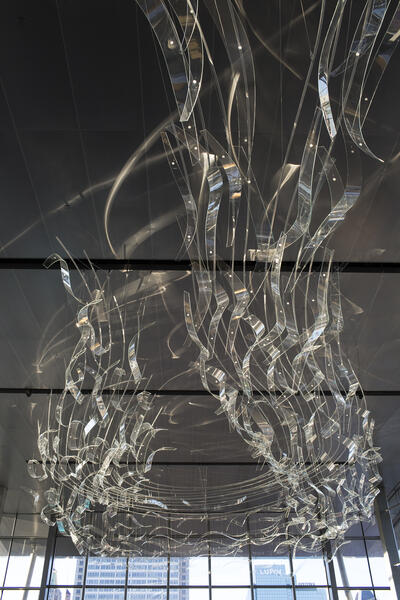 Sea Grass
Sea Grass -
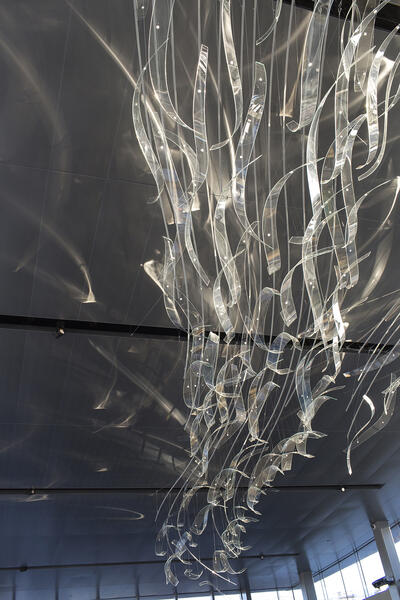 Sea Grass, detail
Sea Grass, detail -
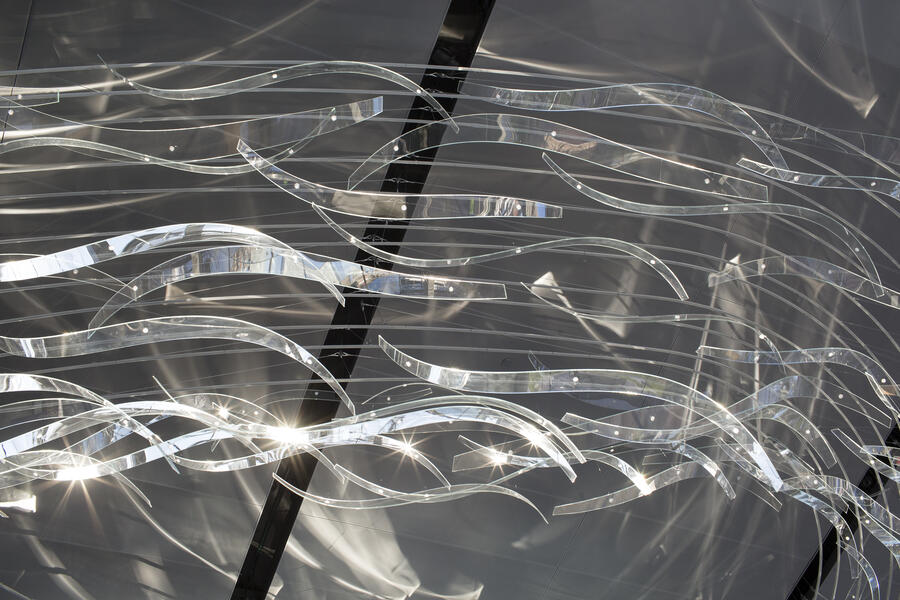 Sea Grass, detail
Sea Grass, detail -
 Community Beacons: Making Waves during Light City 2016The light of the drums was amplified in the Visitor Center, creating a wave of light within the building in response to drumming. In this way, the instrument sculptures were illuminated directly from human power, while the Visitor Center became a dynamic jewel of light, lit from within.
Community Beacons: Making Waves during Light City 2016The light of the drums was amplified in the Visitor Center, creating a wave of light within the building in response to drumming. In this way, the instrument sculptures were illuminated directly from human power, while the Visitor Center became a dynamic jewel of light, lit from within. -
 Kinetic Frenetic Performers during Community Beacons, Making WavesKinetic Frenetic (A Collaboration with Jenn Figg, Matthew McCormack, and David Fakunle) Performers include David Fakunle, Duane Hinton, Jahi Jelani, Brova Tobias, Jabari Jefferson, Themba Sipho Mkhatshwa, Frank Holliday, Charles Watson, and Zakiya Jefferson.
Kinetic Frenetic Performers during Community Beacons, Making WavesKinetic Frenetic (A Collaboration with Jenn Figg, Matthew McCormack, and David Fakunle) Performers include David Fakunle, Duane Hinton, Jahi Jelani, Brova Tobias, Jabari Jefferson, Themba Sipho Mkhatshwa, Frank Holliday, Charles Watson, and Zakiya Jefferson. -
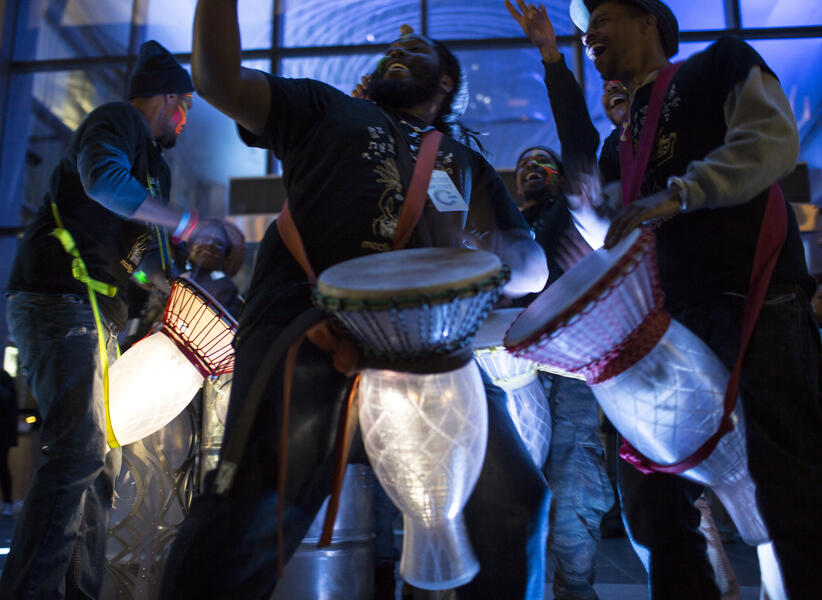 Kinetic Frenetic Performers, during Community Beacons: Making WavesKinetic Frenetic (A Collaboration with Jenn Figg, Matthew McCormack, and David Fakunle) Performers include David Fakunle, Duane Hinton, Jahi Jelani, Brova Tobias, Jabari Jefferson, Themba Sipho Mkhatshwa, Frank Holliday, Charles Watson, and Zakiya Jefferson.
Kinetic Frenetic Performers, during Community Beacons: Making WavesKinetic Frenetic (A Collaboration with Jenn Figg, Matthew McCormack, and David Fakunle) Performers include David Fakunle, Duane Hinton, Jahi Jelani, Brova Tobias, Jabari Jefferson, Themba Sipho Mkhatshwa, Frank Holliday, Charles Watson, and Zakiya Jefferson. -
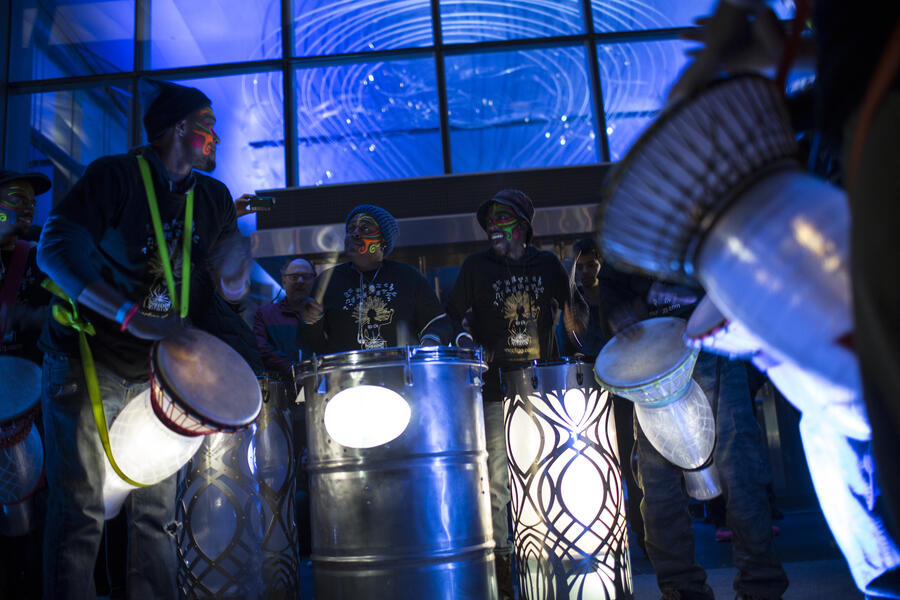 Kinetic Frenetic Performers during Community Beacons: Making WavesKinetic Frenetic (A Collaboration with Jenn Figg, Matthew McCormack, and David Fakunle) Performers include David Fakunle, Duane Hinton, Jahi Jelani, Brova Tobias, Jabari Jefferson, Themba Sipho Mkhatshwa, Frank Holliday, Charles Watson, and Zakiya Jefferson.
Kinetic Frenetic Performers during Community Beacons: Making WavesKinetic Frenetic (A Collaboration with Jenn Figg, Matthew McCormack, and David Fakunle) Performers include David Fakunle, Duane Hinton, Jahi Jelani, Brova Tobias, Jabari Jefferson, Themba Sipho Mkhatshwa, Frank Holliday, Charles Watson, and Zakiya Jefferson. -
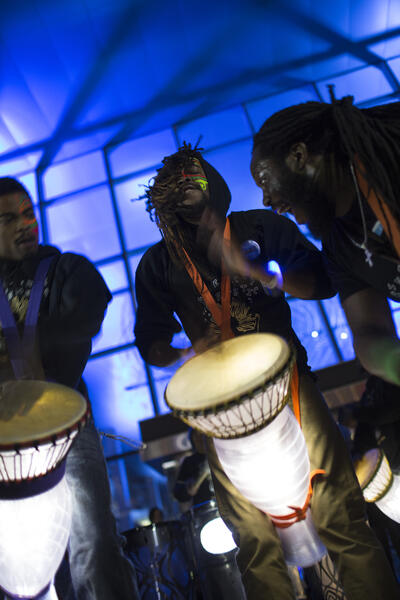 Kinetic Frenetic Performers during Community Beacons: Making WavesKinetic Frenetic (A Collaboration with Jenn Figg, Matthew McCormack, and David Fakunle) Performers include David Fakunle, Duane Hinton, Jahi Jelani, Brova Tobias, Jabari Jefferson, Themba Sipho Mkhatshwa, Frank Holliday, Charles Watson, and Zakiya Jefferson.
Kinetic Frenetic Performers during Community Beacons: Making WavesKinetic Frenetic (A Collaboration with Jenn Figg, Matthew McCormack, and David Fakunle) Performers include David Fakunle, Duane Hinton, Jahi Jelani, Brova Tobias, Jabari Jefferson, Themba Sipho Mkhatshwa, Frank Holliday, Charles Watson, and Zakiya Jefferson. -
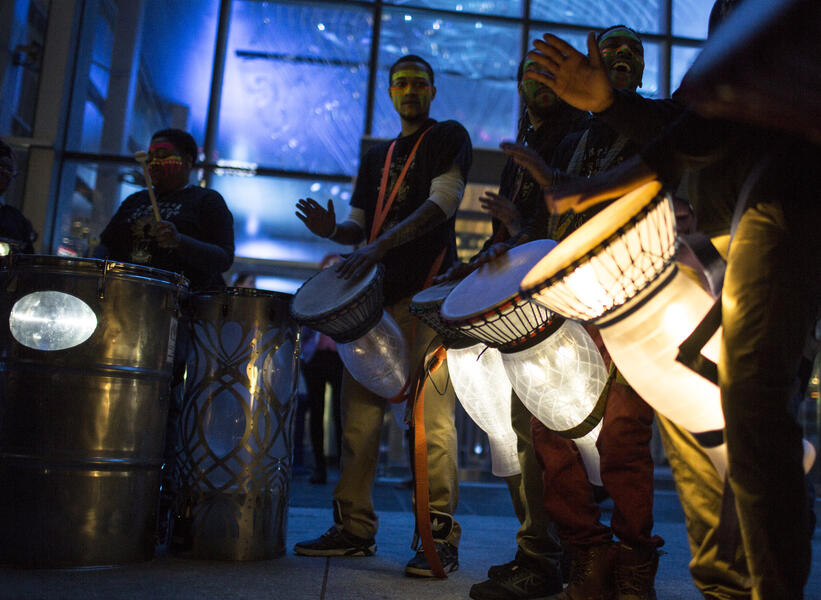 Kinetic Frenetic performers during Community Beacons: Making WavesKinetic Frenetic (A Collaboration with Jenn Figg, Matthew McCormack, and David Fakunle) Performers include David Fakunle, Duane Hinton, Jahi Jelani, Brova Tobias, Jabari Jefferson, Themba Sipho Mkhatshwa, Frank Holliday, Charles Watson, and Zakiya Jefferson.
Kinetic Frenetic performers during Community Beacons: Making WavesKinetic Frenetic (A Collaboration with Jenn Figg, Matthew McCormack, and David Fakunle) Performers include David Fakunle, Duane Hinton, Jahi Jelani, Brova Tobias, Jabari Jefferson, Themba Sipho Mkhatshwa, Frank Holliday, Charles Watson, and Zakiya Jefferson.
small studies and videos
-
Windmill TriptychInspired by the aesthetic of full scale wind turbines, this piece explores energy, power, and the alternating phases of awe and terror turbines invoke.
-
Music for Wood in plasticSteve Reich’s Music for Pieces of Wood (1973) Towson University Percussion Ensemble 2015 Director: Michelle Humphreys Performers: Casey Isanogle, Sarah Dickerson, Dan Puziss, Moy Dumadag, Joe Dennis Kinetic Light Instruments 2010 - 2015
-
Light Drum Amplifier2016 Jimi Hendrix said he was nothing without his Marshall stacks. This array of CRT's is an amplifier for our 3D printed djembe light drum. Powered by the TVout library running on Arduino with a video amplifier. Thank you to Signal Culture!
-
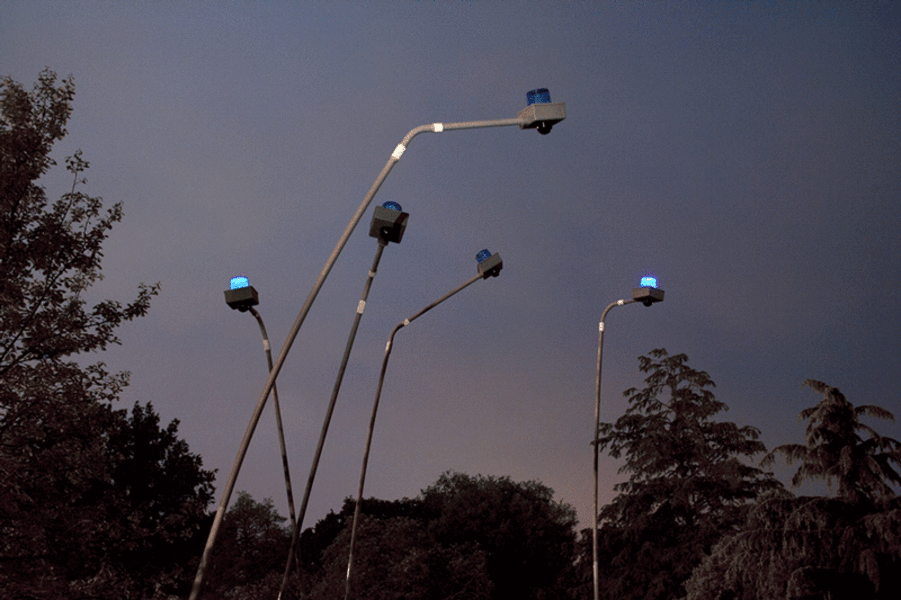 Blue Light District2012 Blue Light District is inspired by Baltimore's blinking blue light surveillance cameras that run 24 hours a day. This stand of blue safety lights iare a constructed ecosystem that satirizes the divisive, penetrating blue flashing lights of Baltimore City. This piece is based on the P.O.D.S.S. project in Baltimore, Maryland. The acronym stands for Portable Overt Digital Surveillance System, of which there were at least 86 within Baltimore City. Originally installed in the city at Pennsylvania Avenue and Laurens Street in 2005, the cameras were intended to deter crime. The highly visible beacons have been a polarizing element of the city's crime strategy, as the cameras failed to produce reliable evidence and neighborhood residents are divided as to their efficacy. The blue lights are symbols of high-crime areas, and are notably absent from a number of Baltimore City neighborhoods. The unsuccessful project cost over $2 million and is being replaced by allegedly more robust ways to monitor and analyze footage. We challenge this urban dystopia and are creating new ways to connect community though light and sound.
Blue Light District2012 Blue Light District is inspired by Baltimore's blinking blue light surveillance cameras that run 24 hours a day. This stand of blue safety lights iare a constructed ecosystem that satirizes the divisive, penetrating blue flashing lights of Baltimore City. This piece is based on the P.O.D.S.S. project in Baltimore, Maryland. The acronym stands for Portable Overt Digital Surveillance System, of which there were at least 86 within Baltimore City. Originally installed in the city at Pennsylvania Avenue and Laurens Street in 2005, the cameras were intended to deter crime. The highly visible beacons have been a polarizing element of the city's crime strategy, as the cameras failed to produce reliable evidence and neighborhood residents are divided as to their efficacy. The blue lights are symbols of high-crime areas, and are notably absent from a number of Baltimore City neighborhoods. The unsuccessful project cost over $2 million and is being replaced by allegedly more robust ways to monitor and analyze footage. We challenge this urban dystopia and are creating new ways to connect community though light and sound. -
 Invasive Ecologies (Spiraling Corn Production)Invasive Ecologies (Spiraling Corn Production), 2015 Paper, ink, adhesive 15” x 9” diameter Spiraling Corn Production stemmed from a desire to visualize the rampant upward spiral of both US corn production and population, representing exactly 150 years of data, plotted every two years. Data is vertically extruded, spiraling counterclockwise around an invisible center point. The vertical walls of the spiral represent the United States’ population growth as documented for the years 1866 through 2014, and projected to 2016, marked in increments of 15 million per every vertical row. Population representation begins at approximately 36 million persons and ends at 318 million persons. Population values are indicated in the innermost spiral and on the very outer rim, and fluctuations account for the uneven top, as the growth of both population and agricultural production is visualized on a steady incline. Plotted at the top line upon this graph is the data for Annual Corn, Harvested Acres, in Millions, marked with red spacers and florescent yellow diamonds. Years are indicated on the bottom edge of the spiral. The horizontal length of the spiral is guided by the number of years for which data is gathered, from 1866 to 2014, and projected data to 2016, with the most recent years positioned centrally in the spiral. Eco-visualization artwork is a political act, situated in context of ecopsychology, specifically solastalgia, and the charged climate of rising awareness regarding environmentalism and sustainability. The sculptural series draws on industrial corn production data, offering a response to the devastation of monoculture landscapes, and a vantage point for considering the politics, policy, and ecology of our food production system. Eco-visualization artwork is a political act, situated in context of ecopsychology, specifically solastalgia, and the charged climate of rising awareness regarding environmentalism and sustainability. The sculptural series draws on industrial corn production data, offering a response to the devastation of monoculture landscapes, and a vantage point for considering the politics, policy, and ecology of our food production system.
Invasive Ecologies (Spiraling Corn Production)Invasive Ecologies (Spiraling Corn Production), 2015 Paper, ink, adhesive 15” x 9” diameter Spiraling Corn Production stemmed from a desire to visualize the rampant upward spiral of both US corn production and population, representing exactly 150 years of data, plotted every two years. Data is vertically extruded, spiraling counterclockwise around an invisible center point. The vertical walls of the spiral represent the United States’ population growth as documented for the years 1866 through 2014, and projected to 2016, marked in increments of 15 million per every vertical row. Population representation begins at approximately 36 million persons and ends at 318 million persons. Population values are indicated in the innermost spiral and on the very outer rim, and fluctuations account for the uneven top, as the growth of both population and agricultural production is visualized on a steady incline. Plotted at the top line upon this graph is the data for Annual Corn, Harvested Acres, in Millions, marked with red spacers and florescent yellow diamonds. Years are indicated on the bottom edge of the spiral. The horizontal length of the spiral is guided by the number of years for which data is gathered, from 1866 to 2014, and projected data to 2016, with the most recent years positioned centrally in the spiral. Eco-visualization artwork is a political act, situated in context of ecopsychology, specifically solastalgia, and the charged climate of rising awareness regarding environmentalism and sustainability. The sculptural series draws on industrial corn production data, offering a response to the devastation of monoculture landscapes, and a vantage point for considering the politics, policy, and ecology of our food production system. Eco-visualization artwork is a political act, situated in context of ecopsychology, specifically solastalgia, and the charged climate of rising awareness regarding environmentalism and sustainability. The sculptural series draws on industrial corn production data, offering a response to the devastation of monoculture landscapes, and a vantage point for considering the politics, policy, and ecology of our food production system. -
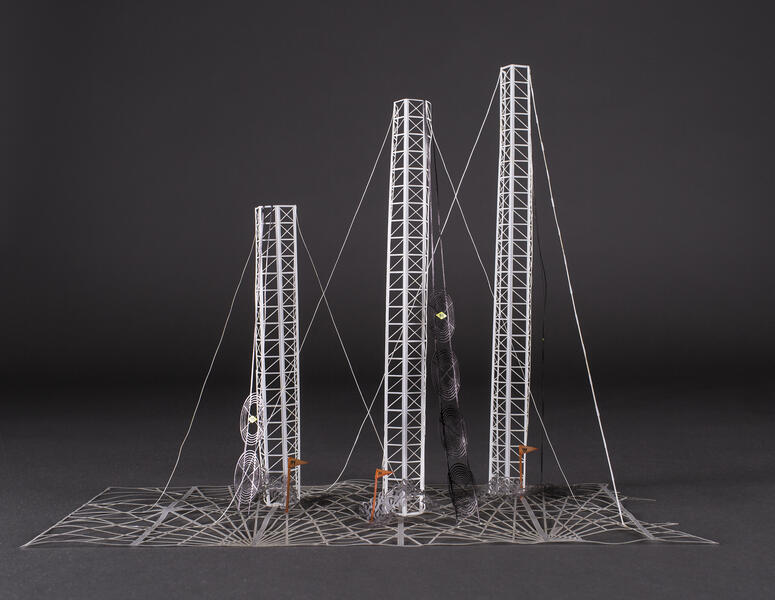 Invasive Ecologies (High-Fructose Towers)Invasive Ecologies (High-Fructose Towers), 2015 Paper, ink, adhesive 14” x 16” x 8” High-Fructose Towers represent a very small slice of data from three non-consecutive years. Rather than representing a series of annualized datasets, the sculpture shows a comparative relationship amongst US population, corn sweetener production and individual consumption of said sweetener. Three towers stand vertically from the flat surface, with separate forms moving up the tower architecture like vines. Each of the impossibly high towers are stabilized with guy lines that cross over one another. The shifts within this piece are subtle but noticeable, from the varying heights of each tower, to the number of concentric rings moving upward, and finally to the amount of amassed corn seeds in front of each tower. The towers buckle and twist because of their architectural structure, a visual response to the broken structure of the US food economy. Each triangular cutout was assigned a numeric value of 1 million in population, representing the total population of the United States for that given year - 1980, 1999, and 2012 - and rises accordingly in height to account for changes. Positioned slightly in front of each tower, amassed individual corn seeds represent the planted acres of corn in millions. These seeds are characterized by a noticeable lack of order, more like shrubbery and not like organized, straight rows. Because of this organic composition they reject a simple visual comparison that could be reached by counting. Lifting out from each mass of corn seeds are concentric radiating rings, each equaling an individual’s annual consumption of corn sweetener.
Invasive Ecologies (High-Fructose Towers)Invasive Ecologies (High-Fructose Towers), 2015 Paper, ink, adhesive 14” x 16” x 8” High-Fructose Towers represent a very small slice of data from three non-consecutive years. Rather than representing a series of annualized datasets, the sculpture shows a comparative relationship amongst US population, corn sweetener production and individual consumption of said sweetener. Three towers stand vertically from the flat surface, with separate forms moving up the tower architecture like vines. Each of the impossibly high towers are stabilized with guy lines that cross over one another. The shifts within this piece are subtle but noticeable, from the varying heights of each tower, to the number of concentric rings moving upward, and finally to the amount of amassed corn seeds in front of each tower. The towers buckle and twist because of their architectural structure, a visual response to the broken structure of the US food economy. Each triangular cutout was assigned a numeric value of 1 million in population, representing the total population of the United States for that given year - 1980, 1999, and 2012 - and rises accordingly in height to account for changes. Positioned slightly in front of each tower, amassed individual corn seeds represent the planted acres of corn in millions. These seeds are characterized by a noticeable lack of order, more like shrubbery and not like organized, straight rows. Because of this organic composition they reject a simple visual comparison that could be reached by counting. Lifting out from each mass of corn seeds are concentric radiating rings, each equaling an individual’s annual consumption of corn sweetener. -
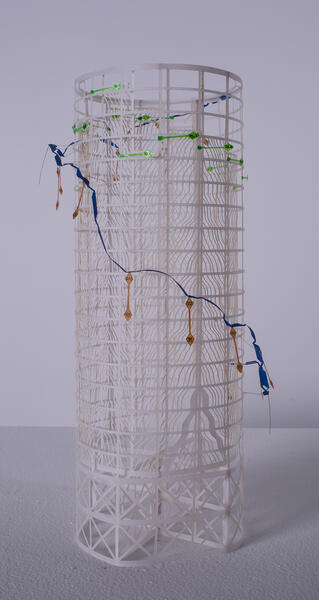 Invasive Ecologies (Biotech Silo)Invasive Ecologies (Biotech Silo), 2015 Paper, ink, adhesive 16" tall x 5" diameter Biotech Silo plots fifteen consecutive years of data pertaining to the pervasive use genetically modified corn seed for production. The sculpture is in the form of a raised agricultural grain storage silo, an element ubiquitous with large-scale agribusiness farming. Architectural complexity achieves a stratified interior and exterior cylinder. An annualized, comparative data representation represents the massive adoption of genetically engineered corn seed since 2000. Annual data is visualized clockwise around the silo and vertically up the walls in two overlapping layers, which overlays harvested acreage with the percentage of biotech acreage. The interior cylinder plots the data for harvested acreage. The data is represented as thin curvilinear rows, growing upward and separated by year. Each vertical column indicates the number of harvested acres, in millions from 2000 - 2015. For example, in 2013 87.45 million acres of corn were harvested and in 2014, 83.13 million acres were harvested. The overall percentage of biotech hybrids is marked numerically upon the overlaid exterior grid, which also functions as an indicator for millions of acres. The vertical and horizontal grid lines are 1/16" in width and ⅜" x ⅞" increments. Each vertical increment denotes 50 million acres of corn harvest, moving vertically from bottom (at zero acres) to top (at 90 million acres). Numerical percentages associated with data Biotech corn planting is plotted upon the exterior cylinder.
Invasive Ecologies (Biotech Silo)Invasive Ecologies (Biotech Silo), 2015 Paper, ink, adhesive 16" tall x 5" diameter Biotech Silo plots fifteen consecutive years of data pertaining to the pervasive use genetically modified corn seed for production. The sculpture is in the form of a raised agricultural grain storage silo, an element ubiquitous with large-scale agribusiness farming. Architectural complexity achieves a stratified interior and exterior cylinder. An annualized, comparative data representation represents the massive adoption of genetically engineered corn seed since 2000. Annual data is visualized clockwise around the silo and vertically up the walls in two overlapping layers, which overlays harvested acreage with the percentage of biotech acreage. The interior cylinder plots the data for harvested acreage. The data is represented as thin curvilinear rows, growing upward and separated by year. Each vertical column indicates the number of harvested acres, in millions from 2000 - 2015. For example, in 2013 87.45 million acres of corn were harvested and in 2014, 83.13 million acres were harvested. The overall percentage of biotech hybrids is marked numerically upon the overlaid exterior grid, which also functions as an indicator for millions of acres. The vertical and horizontal grid lines are 1/16" in width and ⅜" x ⅞" increments. Each vertical increment denotes 50 million acres of corn harvest, moving vertically from bottom (at zero acres) to top (at 90 million acres). Numerical percentages associated with data Biotech corn planting is plotted upon the exterior cylinder. -
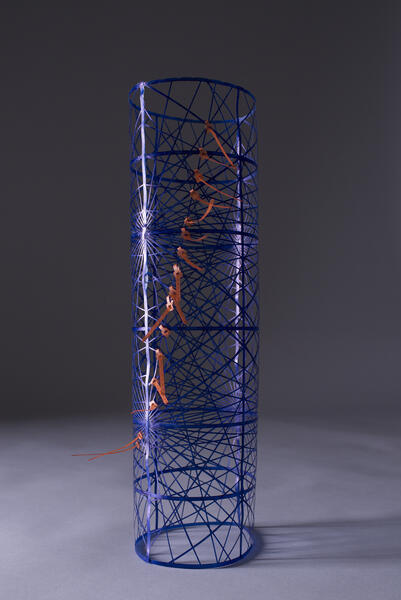 Invasive Ecologies (BioTech II)
Invasive Ecologies (BioTech II) -
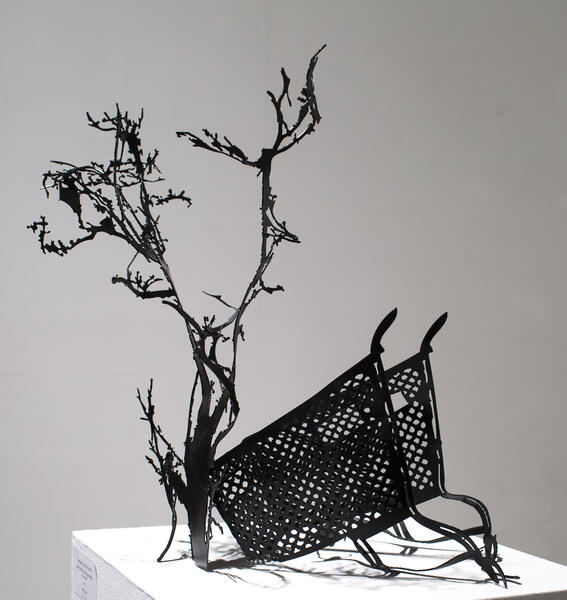 Abandoned on County Road 802013 Steel, paint 23" x 15" x 12"
Abandoned on County Road 802013 Steel, paint 23" x 15" x 12" -
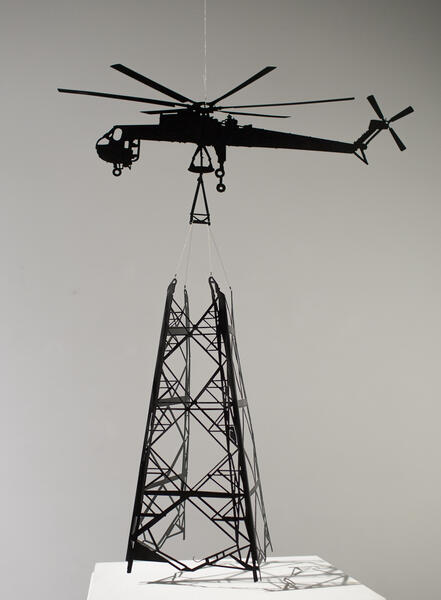 Air Drop Transport2013 Plasma Cut Steel, Paint, Wire
Air Drop Transport2013 Plasma Cut Steel, Paint, Wire
Night Magic and Aurora Borealis
Site-Specific Installation
Winter Light Garden and Flower Show, Phipps Conservatory and Botanical Garden, Pittsburgh, PA
We are fascinated by the beneficial and malevolent forces in our natural world. Rapid globalization and climate change contribute to the transference of species into environments where their population can explode unchecked, wherein a beautiful flower may grow rampant in another place, thus transforming it into a rampant weed. An unusual mushroom or flower may lead to unpleasant or euphoric states. Nature simultaneously overgrows our structures while we build, outpacing our obsolescence. These glass installations combine the raw power of energy- both human energy and the physical energy of heat to transform molten material into homages to dynamic plant species.
Night Magic:
The evening rhythm and atmosphere of the Phipps Conservatory, in Pittsburgh, Pennsylvania inspires Night Magic. Glass houses are a protected world in contrast to the urban landscape found outside its walls. We imagined witnessing the Aurora Borealis peeking through the leafy foliage of the Conservatory’s trees. The installation begins with gently glowing glass botanicals nestled in the planting spaces.
Night Magic is a time-based, unfolding, immersive visual recreation of the night sky featuring illuminated glass sculptures. Underneath this shifting night sky, nestled among the living plants and trees, are hundreds of glass botanicals specific to each room in the West Wing of the Conservatory.
-
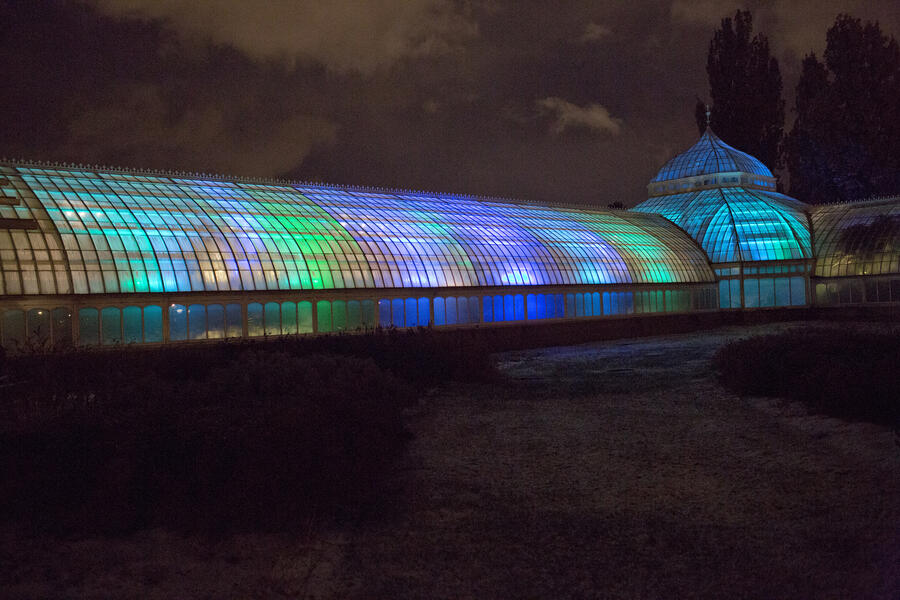 Night Magic, Aurora Borealis
Night Magic, Aurora Borealis -
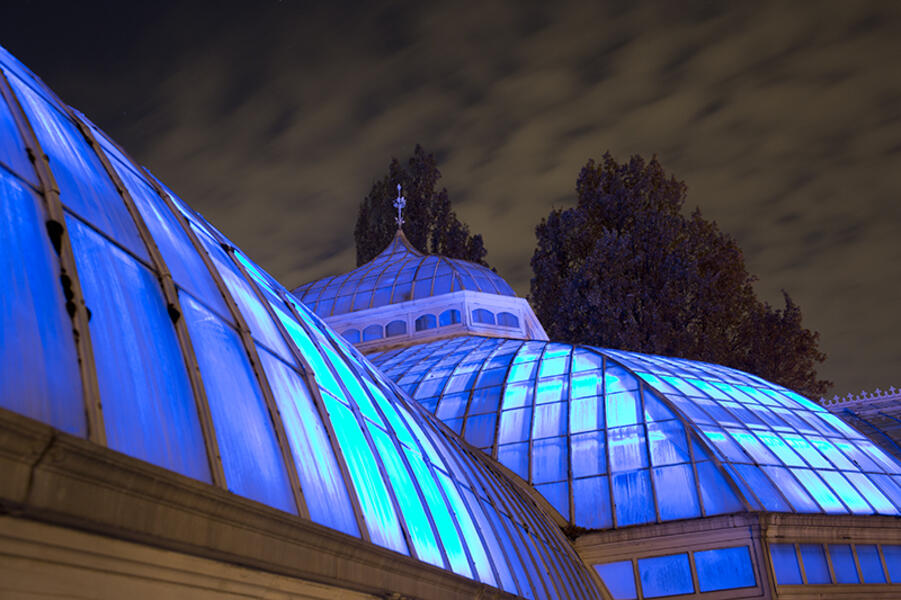 Night MagicExterior View of Aurora Borealis Programmed Lighting Installation Site-Specific Installation at the Phipps Conservatory, Pittsburgh, PA
Night MagicExterior View of Aurora Borealis Programmed Lighting Installation Site-Specific Installation at the Phipps Conservatory, Pittsburgh, PA -
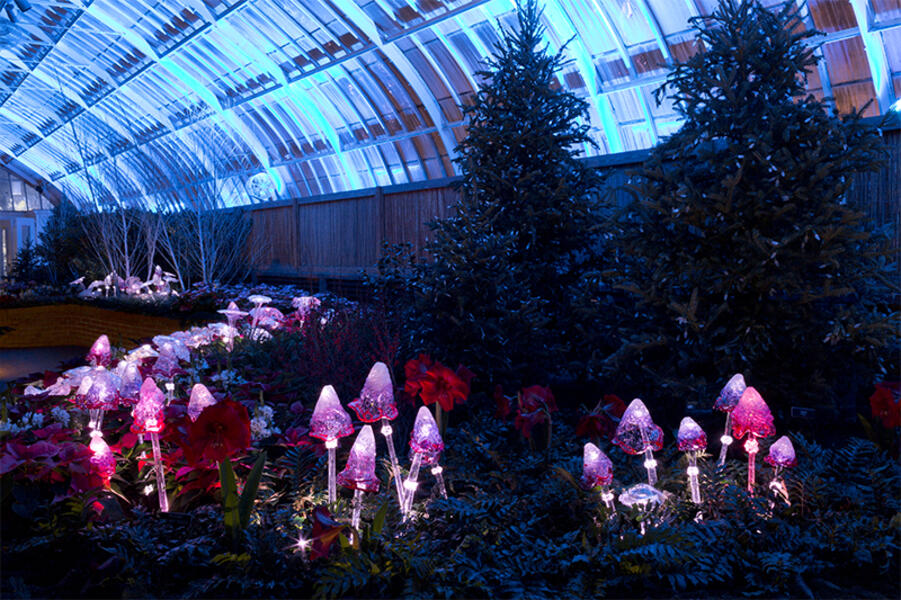 Night MagicNight Magic: Aurora Borealis and Mushroom Forest, 2013 Phipps Conservatory and Botanical Gardens, Pittsburgh, PA RGB LEDs, Custom Programming, Handblown glass The glass botanicals were installed in 5 different rooms, each installation area varying in scale. As pictured: 60’ long, 20’ wide, 36” tall. Glass houses are a protected world in contrast to the urban landscape found outside its walls, a place wherein unusual and protected species can thrive. In this alternate universe Psilocybin mushrooms are a celebrated part of our ecology.
Night MagicNight Magic: Aurora Borealis and Mushroom Forest, 2013 Phipps Conservatory and Botanical Gardens, Pittsburgh, PA RGB LEDs, Custom Programming, Handblown glass The glass botanicals were installed in 5 different rooms, each installation area varying in scale. As pictured: 60’ long, 20’ wide, 36” tall. Glass houses are a protected world in contrast to the urban landscape found outside its walls, a place wherein unusual and protected species can thrive. In this alternate universe Psilocybin mushrooms are a celebrated part of our ecology. -
 Night MagicNight Magic: Aurora Borealis and Mushroom Forest, 2013 Phipps Conservatory and Botanical Gardens, Pittsburgh, PA RGB LEDs, Custom Programming, Handblown glass The glass botanicals were installed in 5 different rooms, each installation area varying in scale. As pictured: 60’ long, 20’ wide, 36” tall. Glass houses are a protected world in contrast to the urban landscape found outside its walls, a place wherein unusual and protected species can thrive. In this alternate universe Psilocybin mushrooms are a celebrated part of our ecology.
Night MagicNight Magic: Aurora Borealis and Mushroom Forest, 2013 Phipps Conservatory and Botanical Gardens, Pittsburgh, PA RGB LEDs, Custom Programming, Handblown glass The glass botanicals were installed in 5 different rooms, each installation area varying in scale. As pictured: 60’ long, 20’ wide, 36” tall. Glass houses are a protected world in contrast to the urban landscape found outside its walls, a place wherein unusual and protected species can thrive. In this alternate universe Psilocybin mushrooms are a celebrated part of our ecology. -
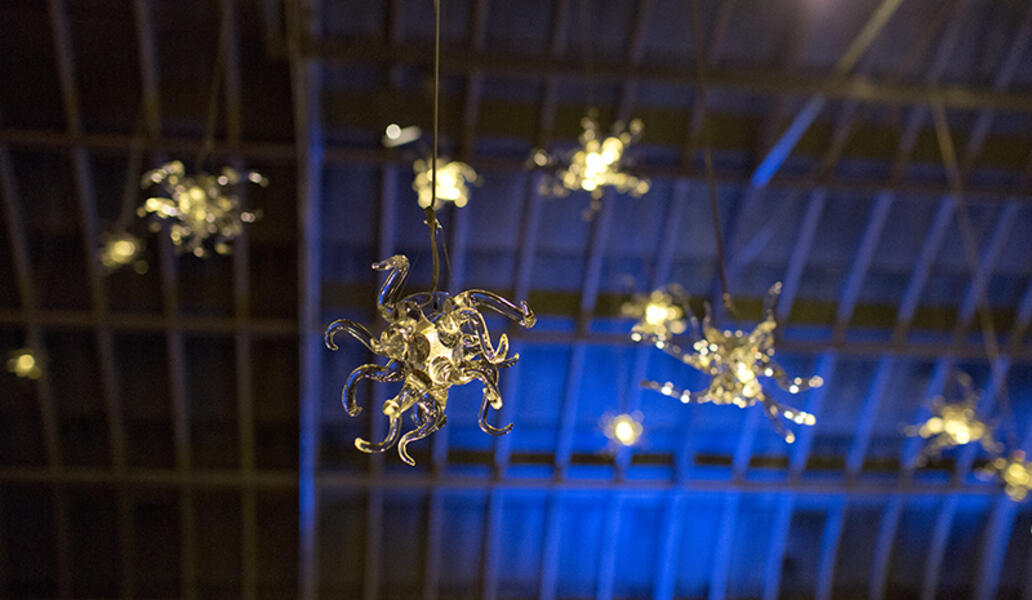 Night Magic, Neurons (detail)Neuron Constellation Dimensions Variable Glass, Steel, LEDs Site-Specific Installation at the Phipps Conservatory, Pittsburgh, PA
Night Magic, Neurons (detail)Neuron Constellation Dimensions Variable Glass, Steel, LEDs Site-Specific Installation at the Phipps Conservatory, Pittsburgh, PA -
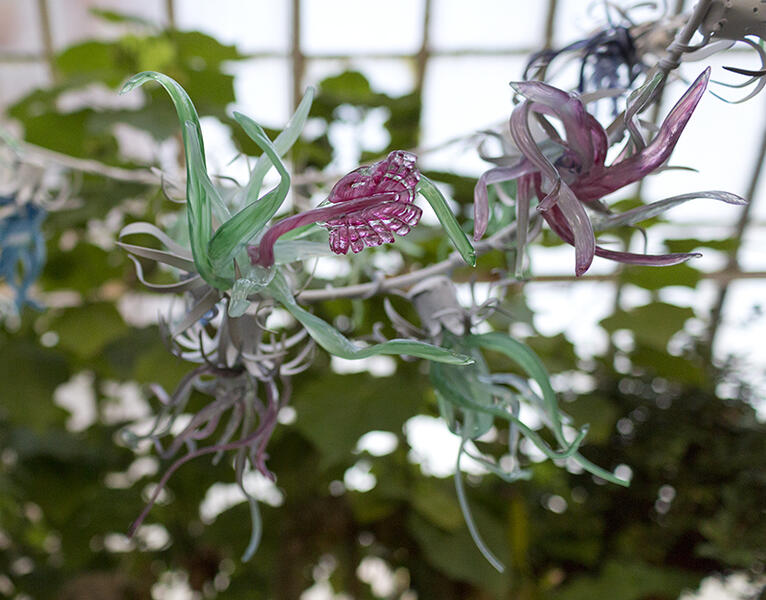 Night Magic, TillandsiaTillandsia (day view) Dimensions Variable Glass, Steel, LEDs Site-Specific Installation at the Phipps Conservatory, Pittsburgh, PA
Night Magic, TillandsiaTillandsia (day view) Dimensions Variable Glass, Steel, LEDs Site-Specific Installation at the Phipps Conservatory, Pittsburgh, PA -
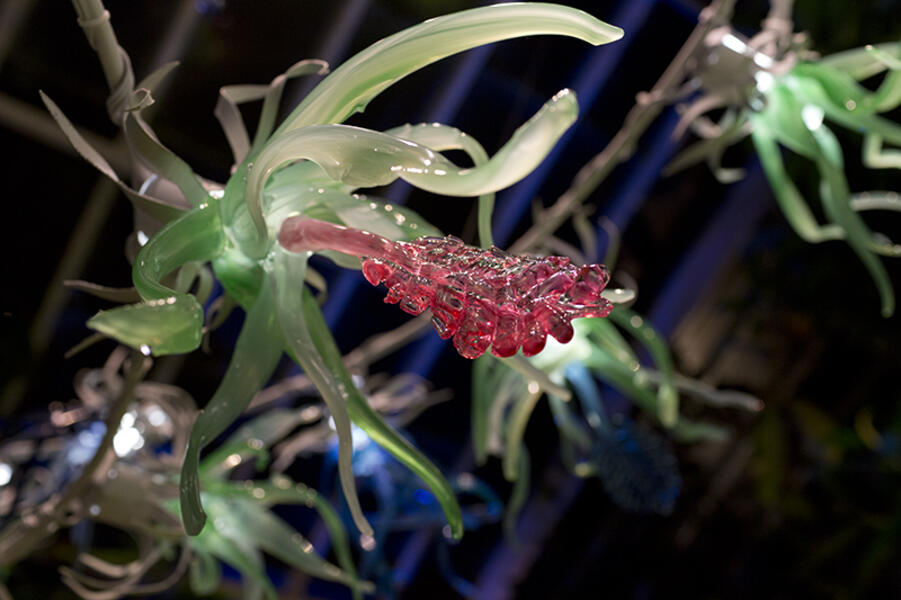 Night Magic, TillandsiaTillandsia (night view) Dimensions Variable Glass, Steel, LEDs Site-Specific Installation at the Phipps Conservatory, Pittsburgh, PA
Night Magic, TillandsiaTillandsia (night view) Dimensions Variable Glass, Steel, LEDs Site-Specific Installation at the Phipps Conservatory, Pittsburgh, PA -
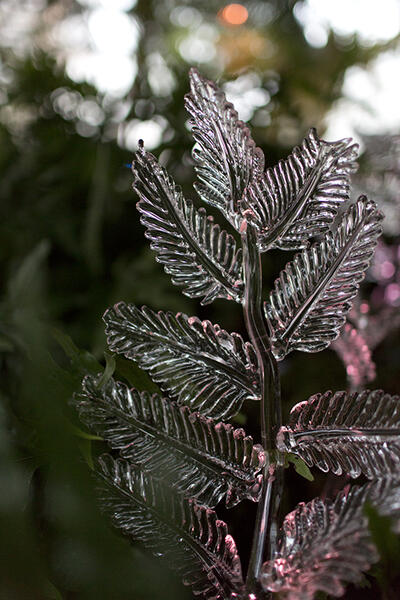 Night Magic, FernFerns Dimensions Variable Glass, Steel, LEDs Site-Specific Installation at the Phipps Conservatory, Pittsburgh, PA
Night Magic, FernFerns Dimensions Variable Glass, Steel, LEDs Site-Specific Installation at the Phipps Conservatory, Pittsburgh, PA -
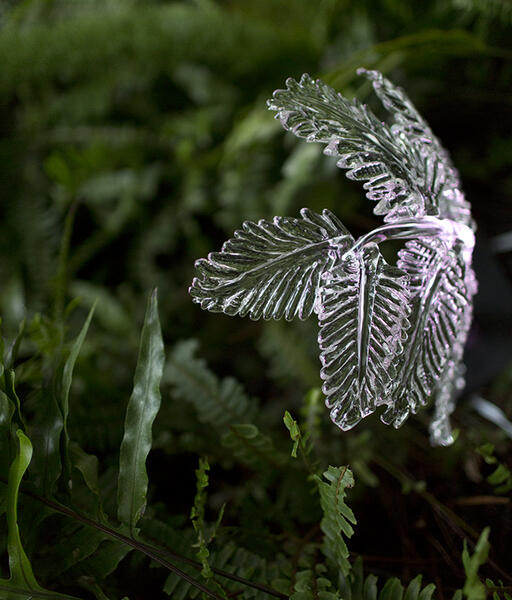 Night Magic, FernFerns Dimensions Variable Glass, Steel, LEDs Site-Specific Installation at the Phipps Conservatory, Pittsburgh, PA
Night Magic, FernFerns Dimensions Variable Glass, Steel, LEDs Site-Specific Installation at the Phipps Conservatory, Pittsburgh, PA -
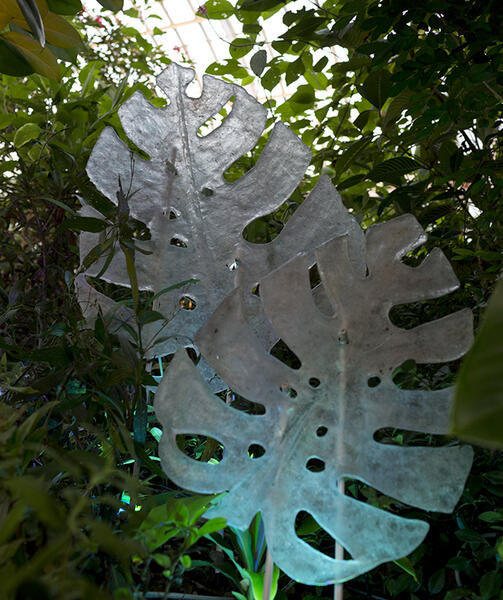 Night Magic, Swiss Cheese MonsteraSwiss Cheese Leaves Dimensions Variable Cast Glass, Steel, LEDs Site-Specific Installation at the Phipps Conservatory, Pittsburgh, PA
Night Magic, Swiss Cheese MonsteraSwiss Cheese Leaves Dimensions Variable Cast Glass, Steel, LEDs Site-Specific Installation at the Phipps Conservatory, Pittsburgh, PA
Strata Extraction
Mixed Media: plastic, paint, steel, paperboard, salt.
2014
On Mars, the blowing winds twirl red dust up from the surface.
Without an atmosphere, the crimson spirals soon bleach white.
The planet’s core cooled too quickly– the only sign of life,
Our rovers, extracting salt and sand from icy layers.
We are moved by the passion of the researchers and engineers who collaborate to study Mars’ massive and distant landscape grain by grain. Strata Extraction is a homage to the imagination and vision of people and the pursuit of technological perfection.
Elements of the sculpture include: a capillary array from a DNA analyzer; a series of stratified and topographic “transverse aeolian ridges” called TARs from the Noctis Labyrinthus region of Mars; and the Curiosity Rover.
This site specific work was created for “Back to Earth” exhibition at the Q Gallery in the Milton S. Eisenhower Library at Johns Hopkins University.
-
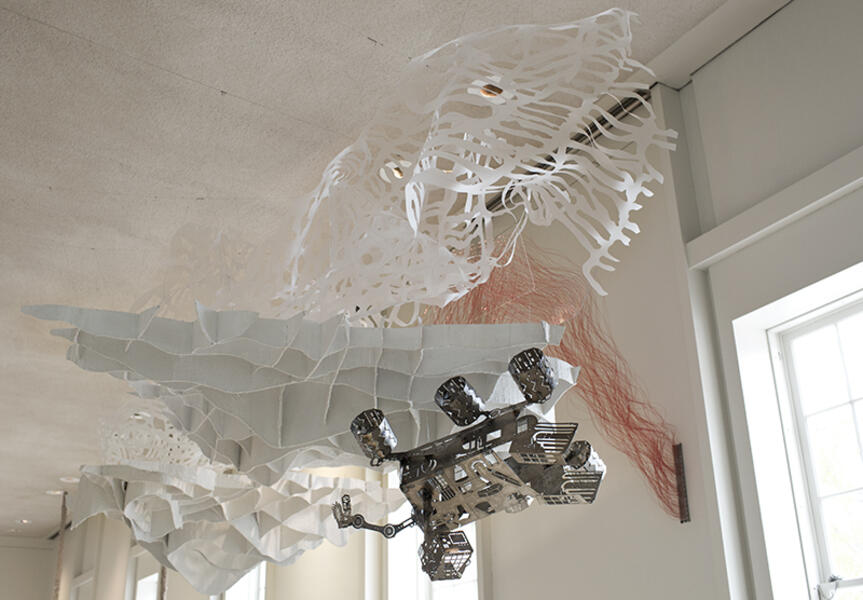 Strata Extraction2014 Dimensions Variable Mixed Media: plastic, paint, steel, paperboard, salt.
Strata Extraction2014 Dimensions Variable Mixed Media: plastic, paint, steel, paperboard, salt. -
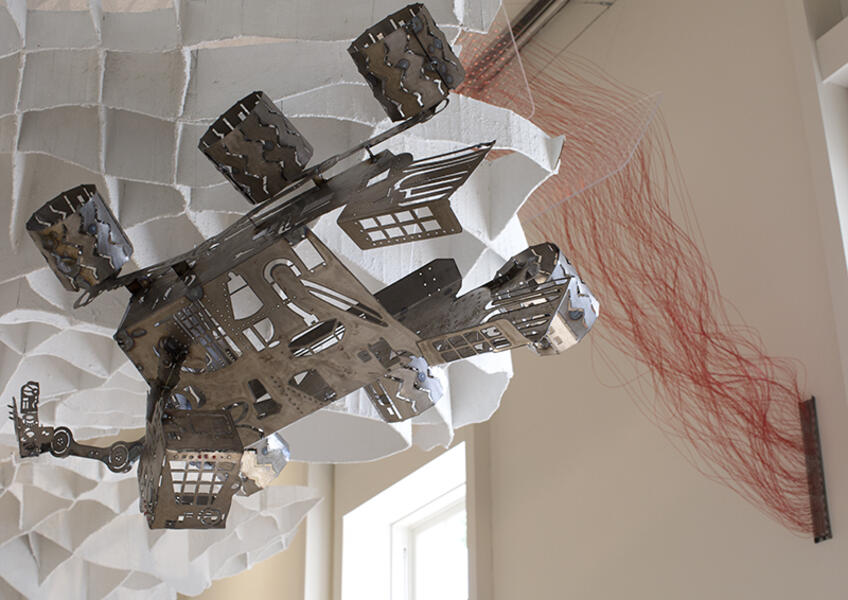 Strata Extraction2014 Dimensions Variable Mixed Media: plastic, paint, steel, paperboard, salt.
Strata Extraction2014 Dimensions Variable Mixed Media: plastic, paint, steel, paperboard, salt. -
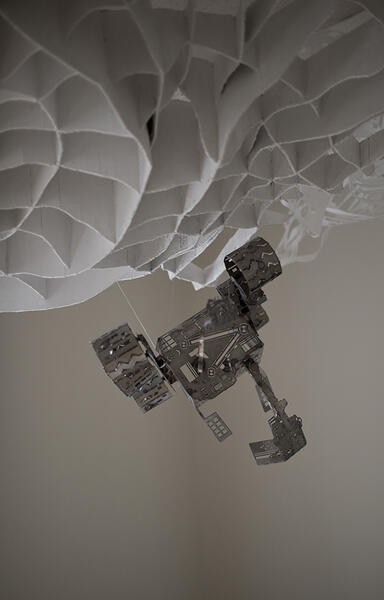 Strata Extracton2014 Dimensions Variable Mixed Media: plastic, paint, steel, paperboard, salt.
Strata Extracton2014 Dimensions Variable Mixed Media: plastic, paint, steel, paperboard, salt. -
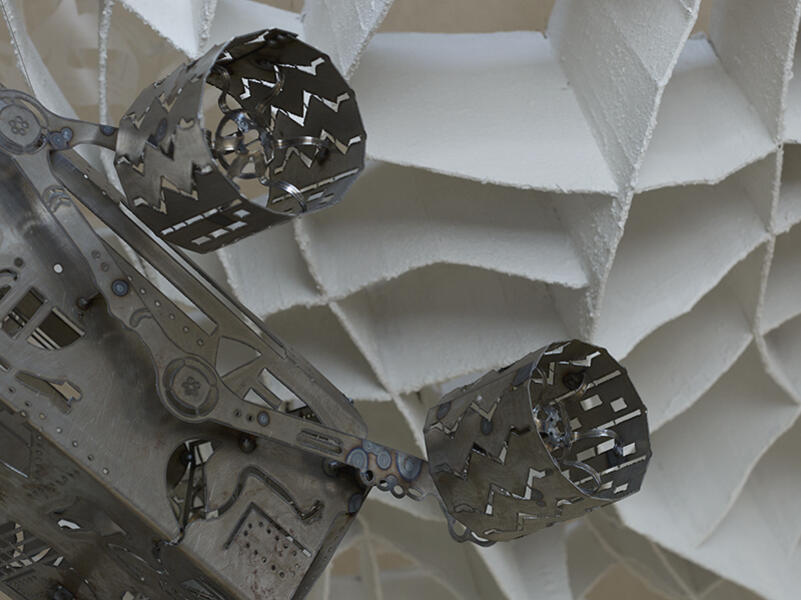 Strata Extraction2014 Dimensions Variable Mixed Media: plastic, paint, steel, paperboard, salt.
Strata Extraction2014 Dimensions Variable Mixed Media: plastic, paint, steel, paperboard, salt. -
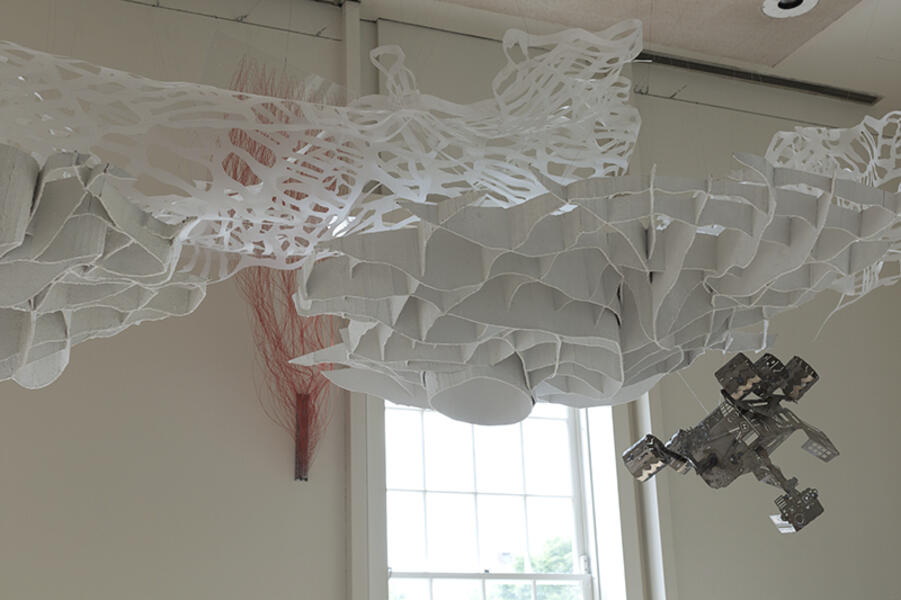 Strata Extraction2014 Dimensions Variable Mixed Media: plastic, paint, steel, paperboard, salt.
Strata Extraction2014 Dimensions Variable Mixed Media: plastic, paint, steel, paperboard, salt. -
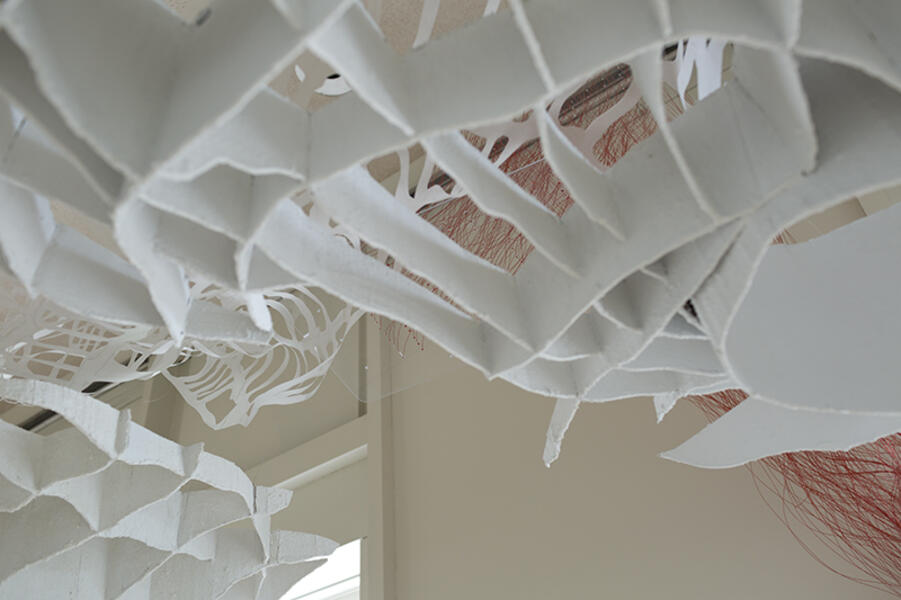 Strata Extraction2014 Dimensions Variable Mixed Media: plastic, paint, steel, paperboard, salt.
Strata Extraction2014 Dimensions Variable Mixed Media: plastic, paint, steel, paperboard, salt. -
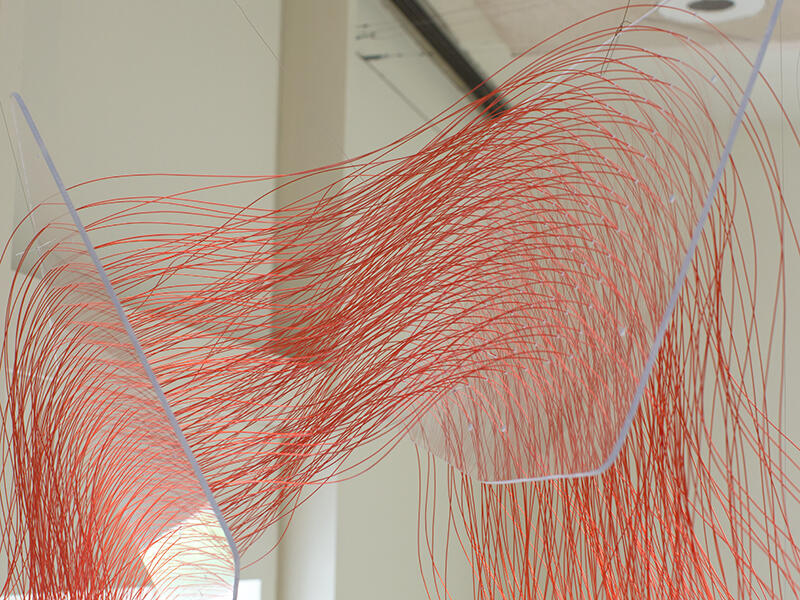 Strata Extraction2014 Dimensions Variable Mixed Media: plastic, paint, steel, paperboard, salt.
Strata Extraction2014 Dimensions Variable Mixed Media: plastic, paint, steel, paperboard, salt.
